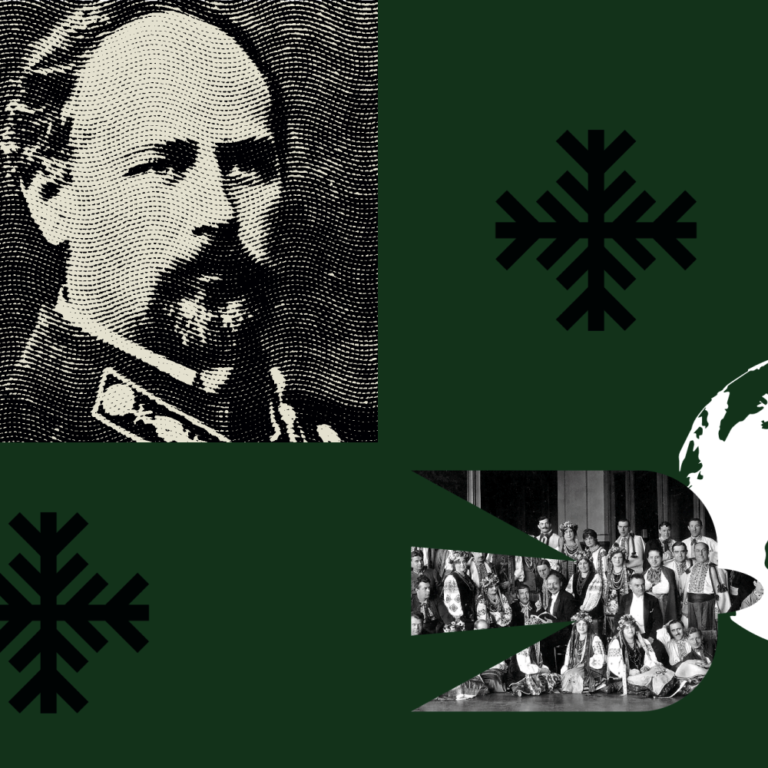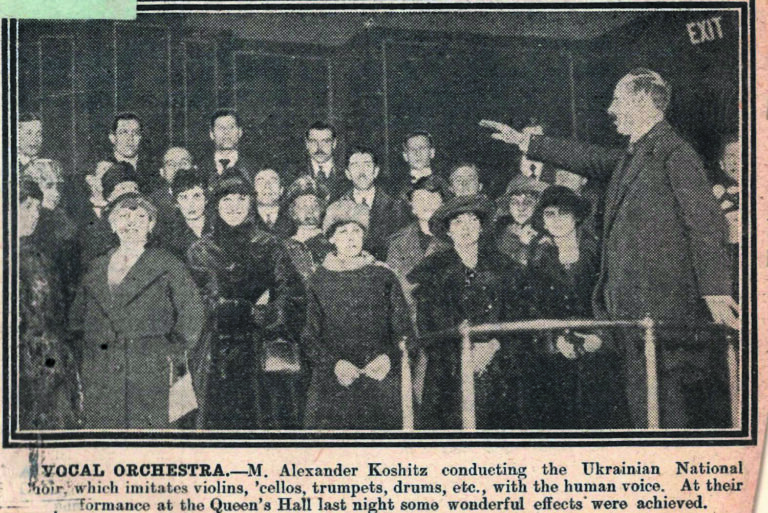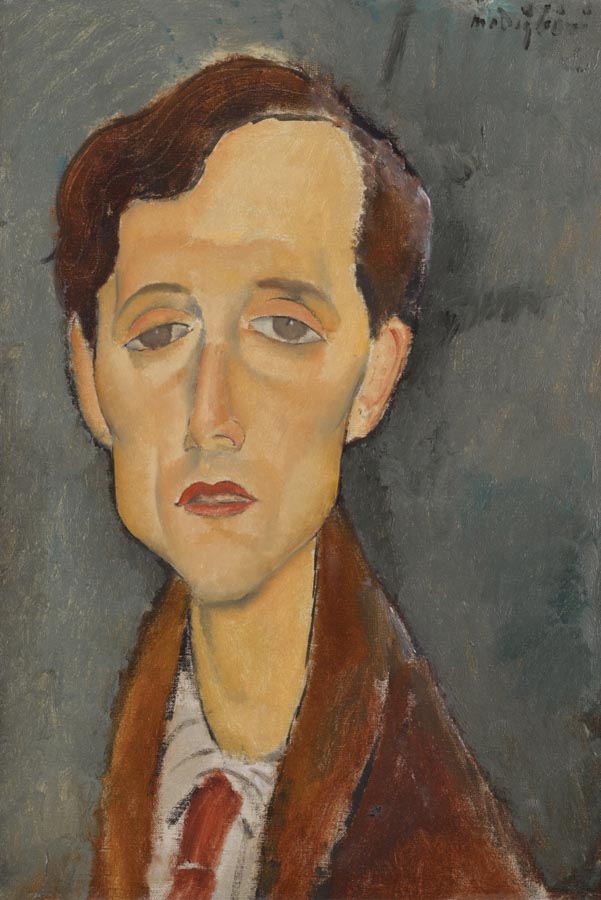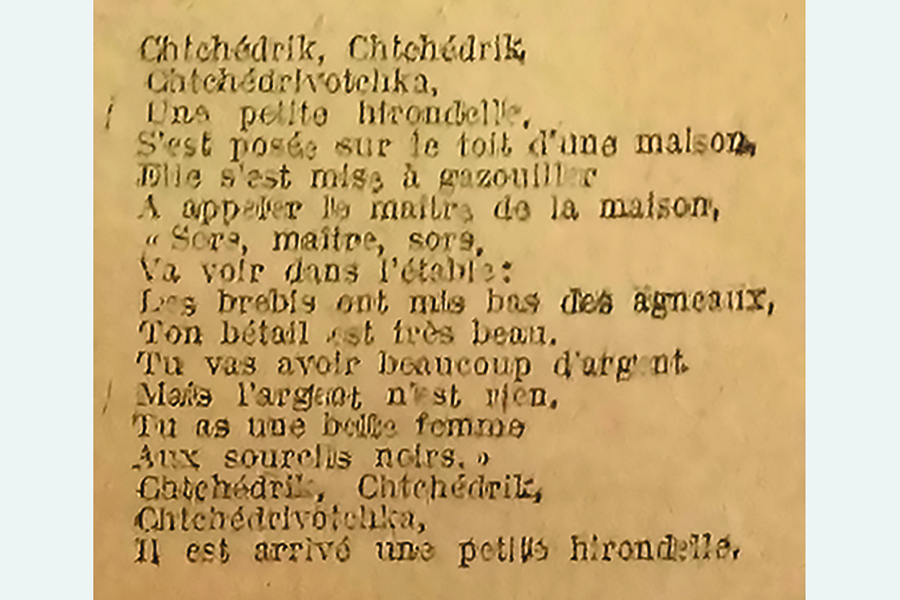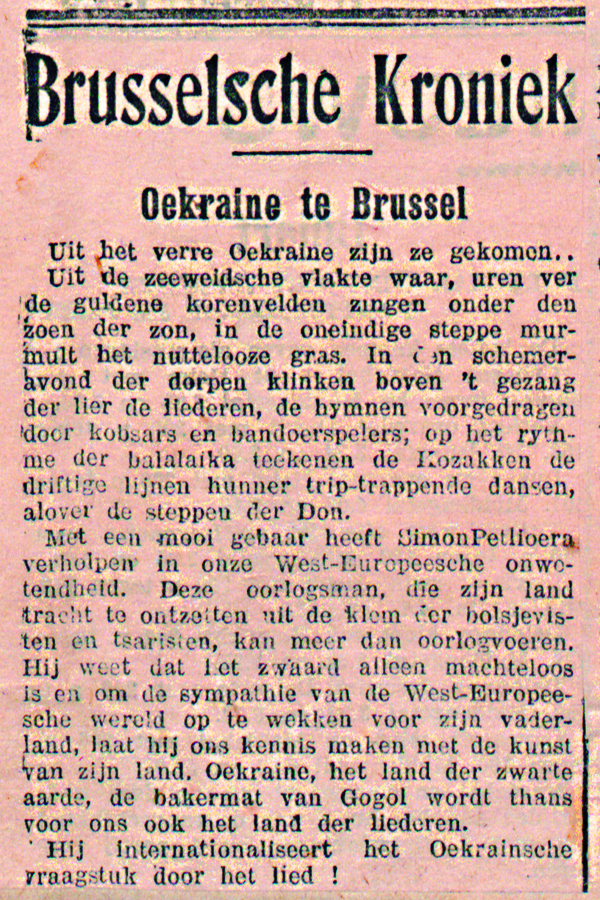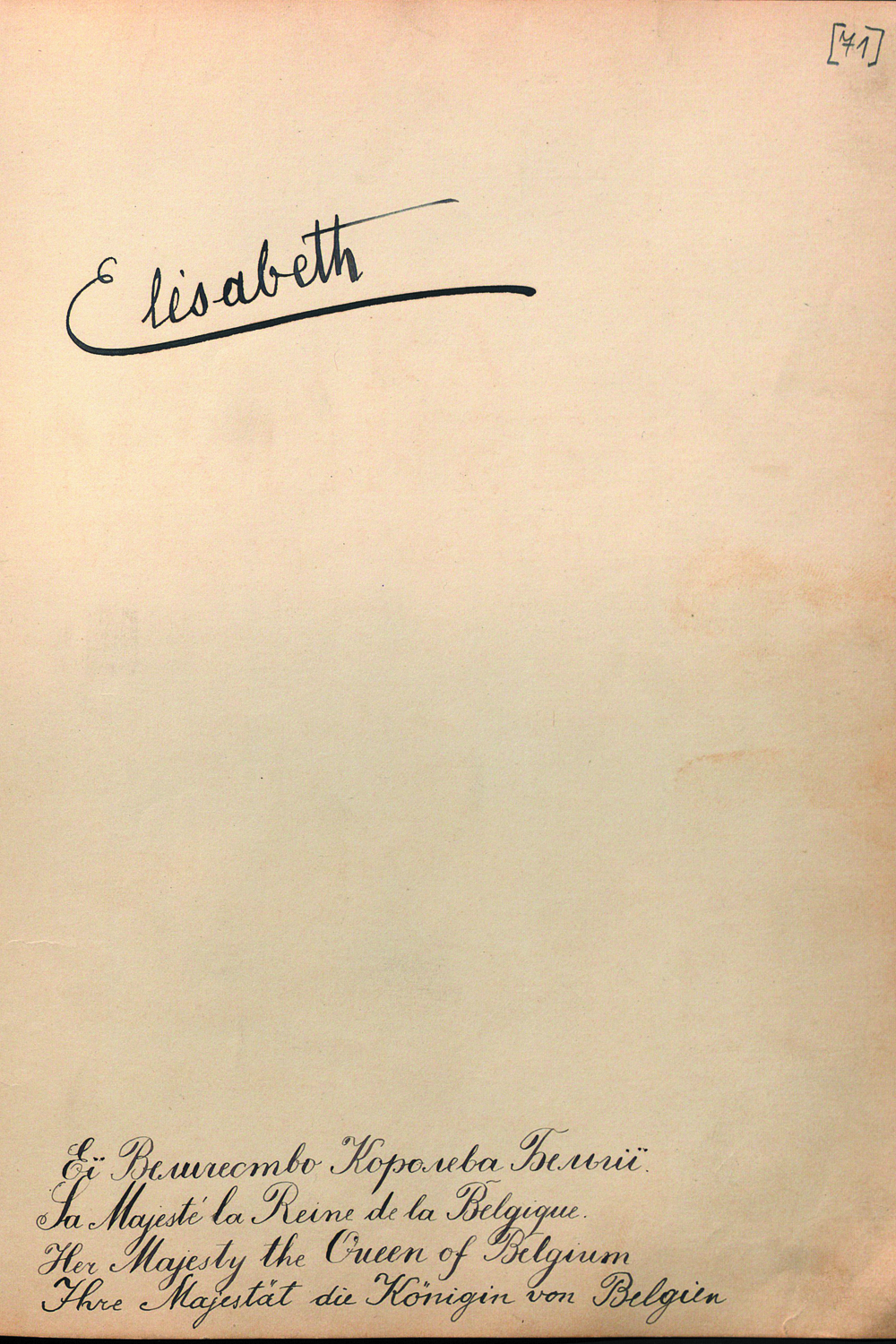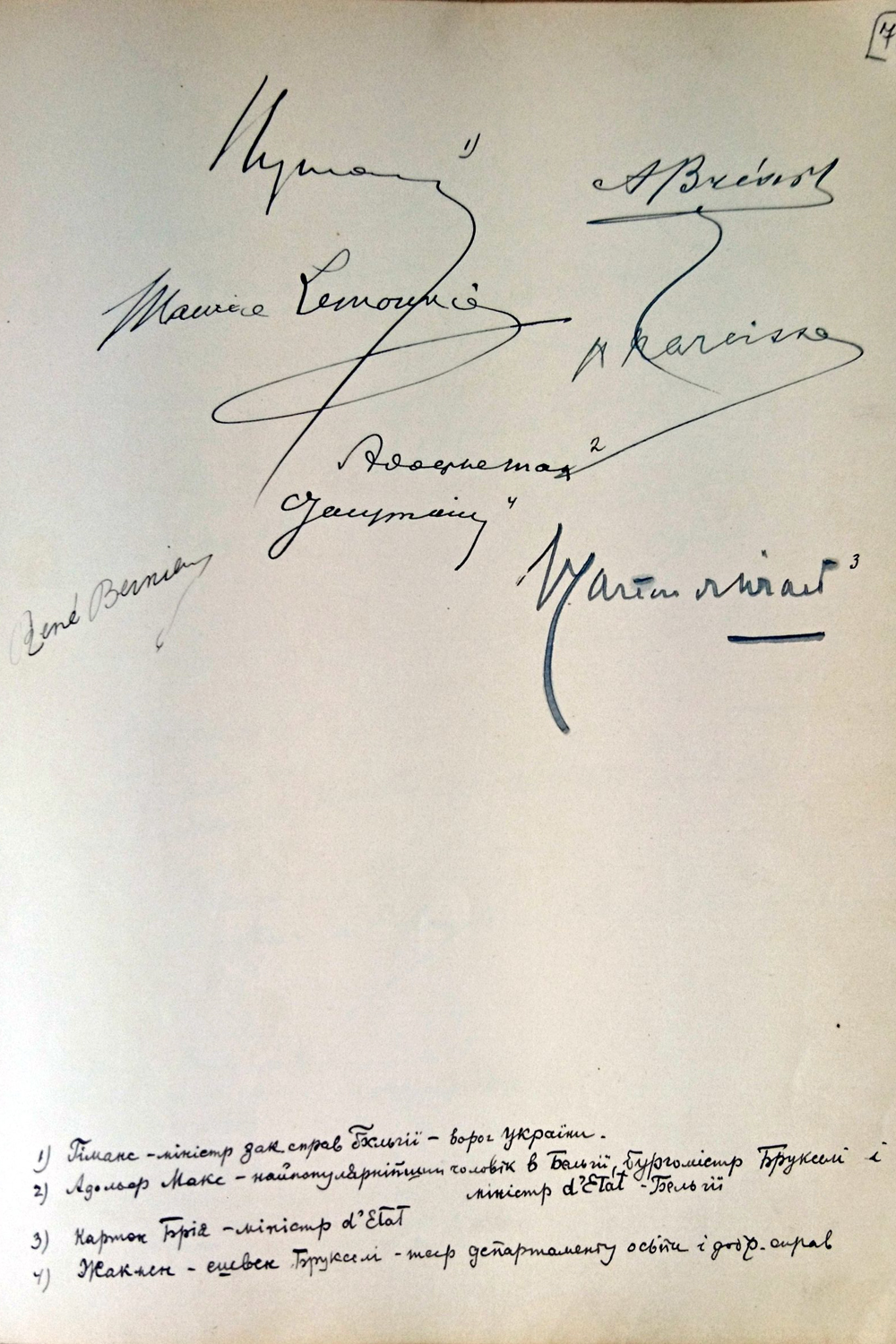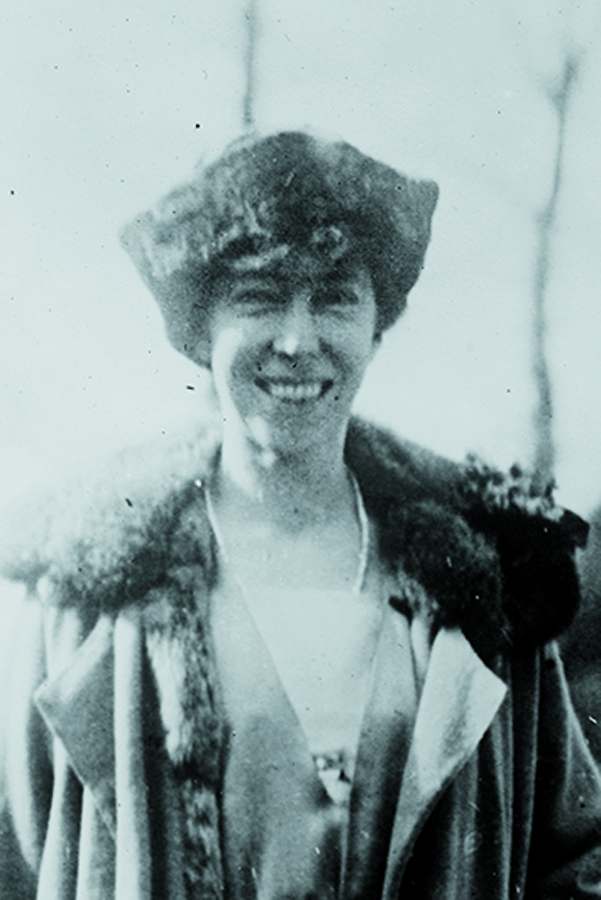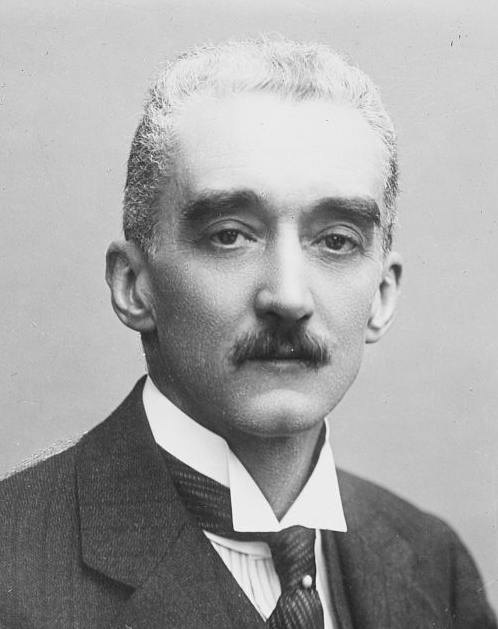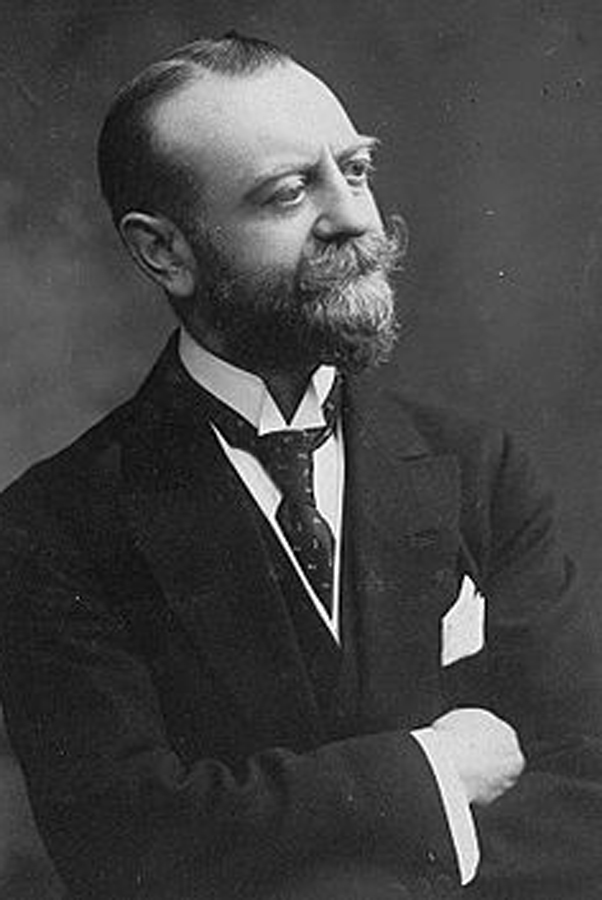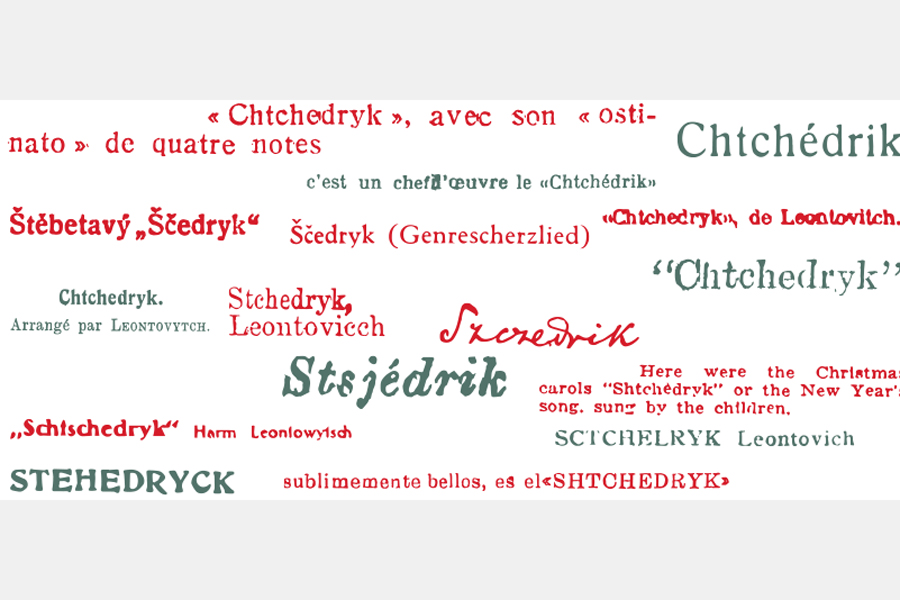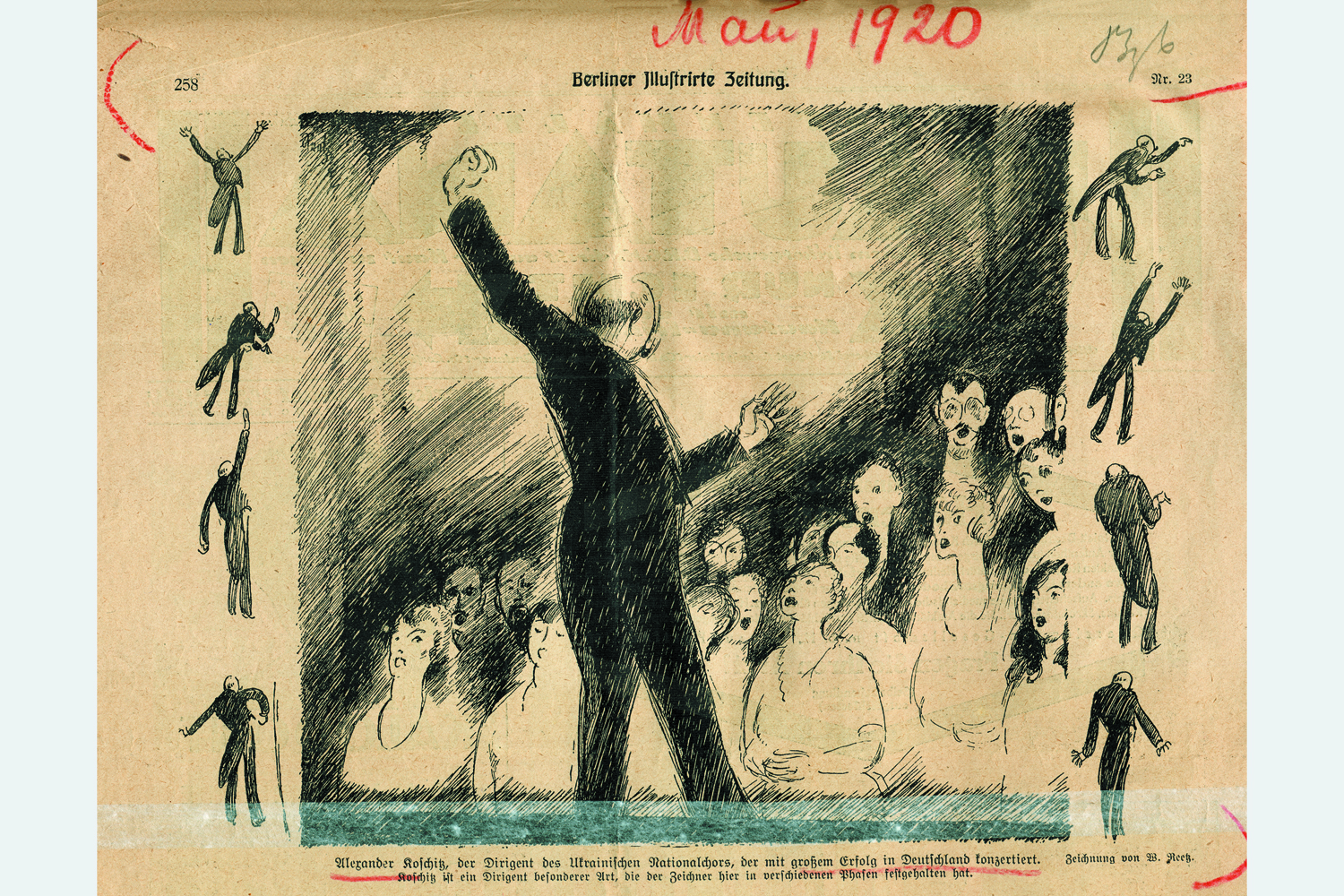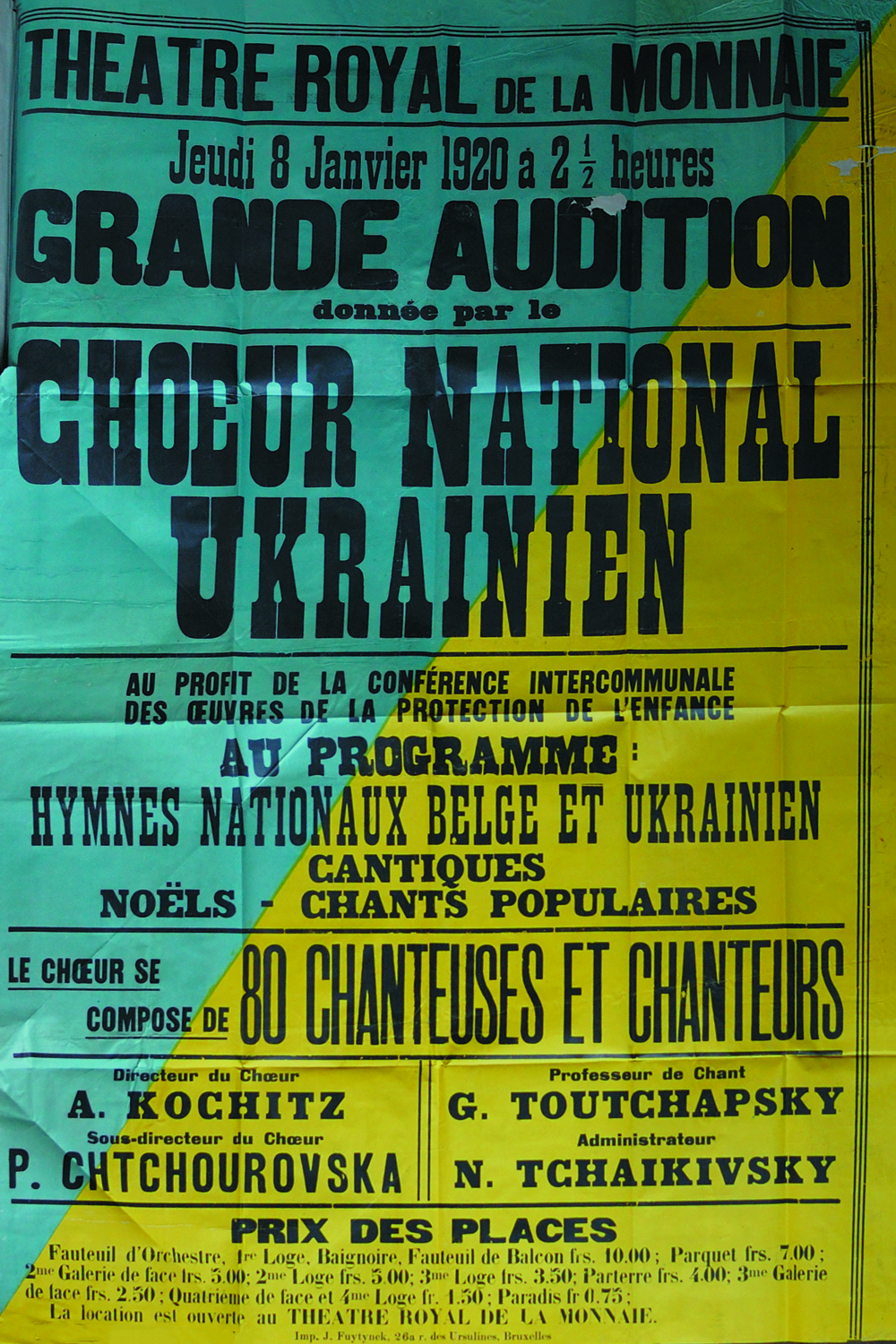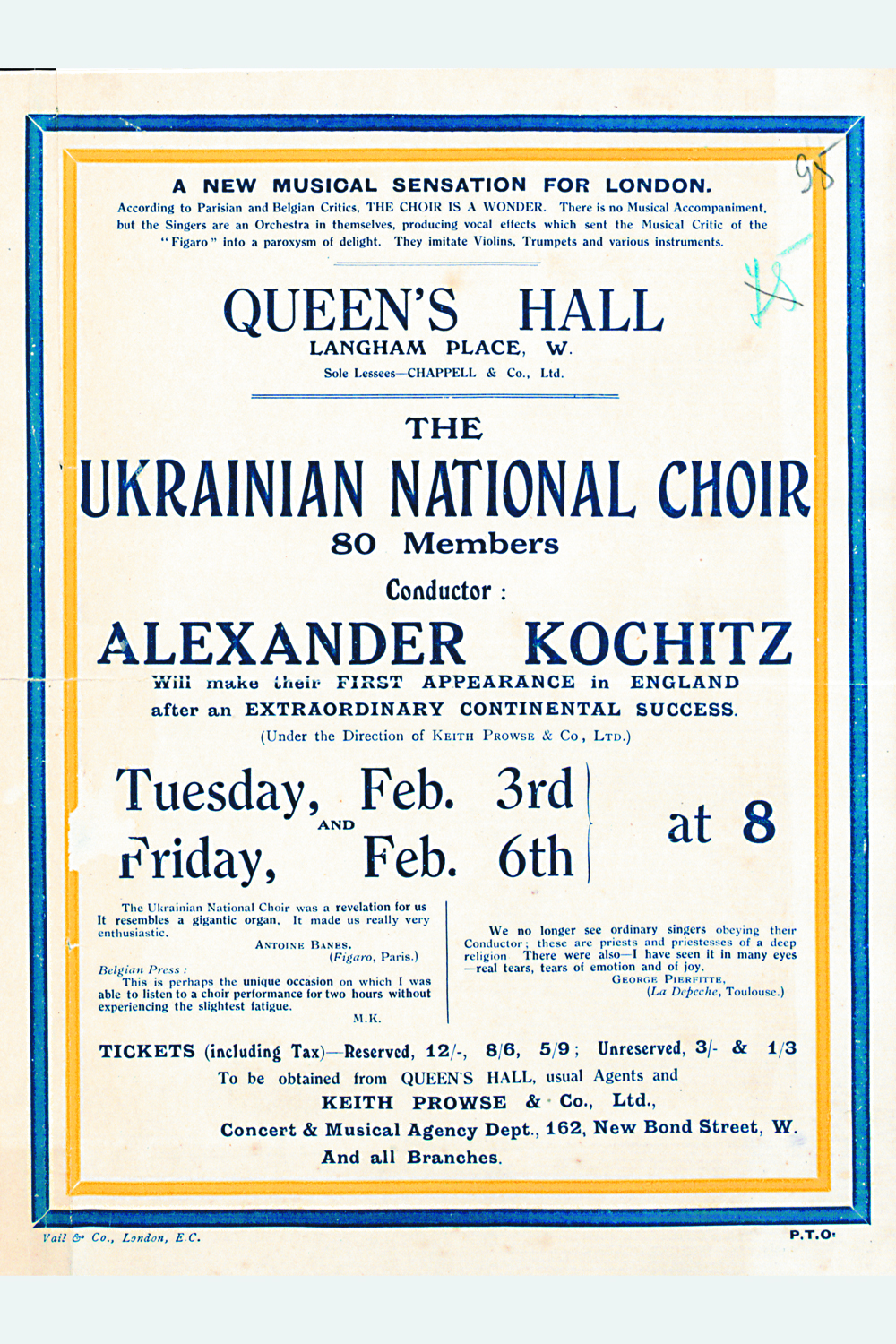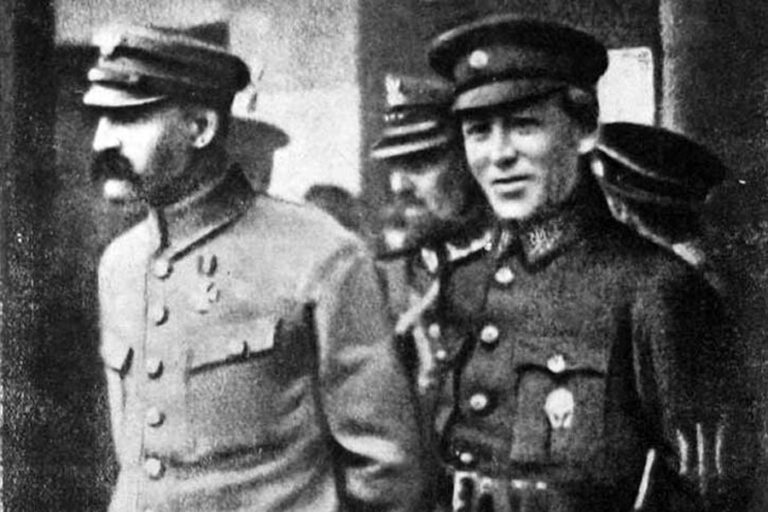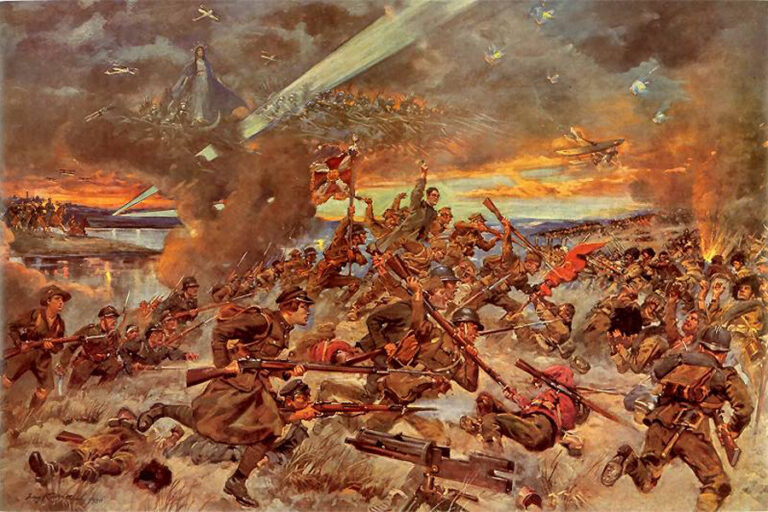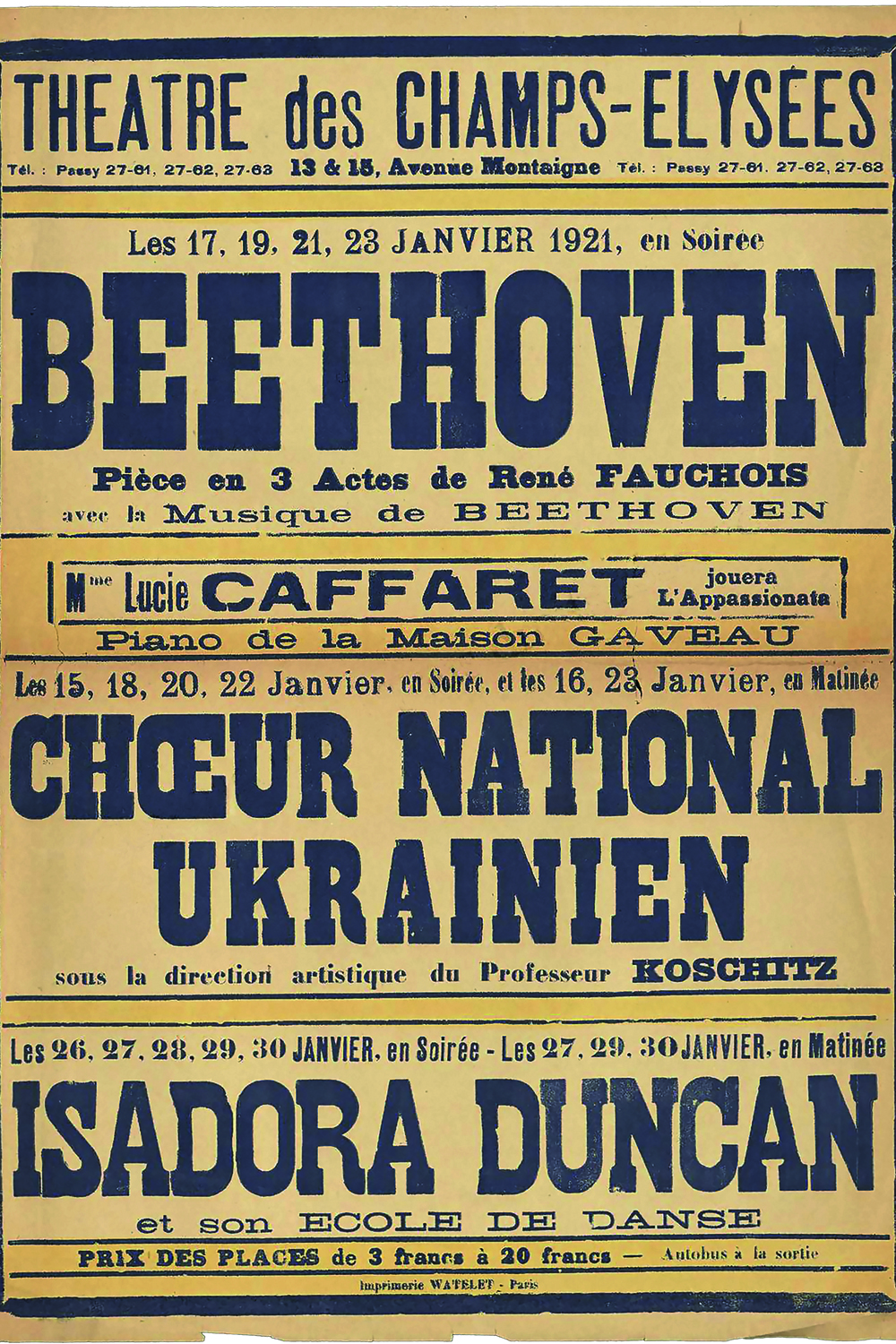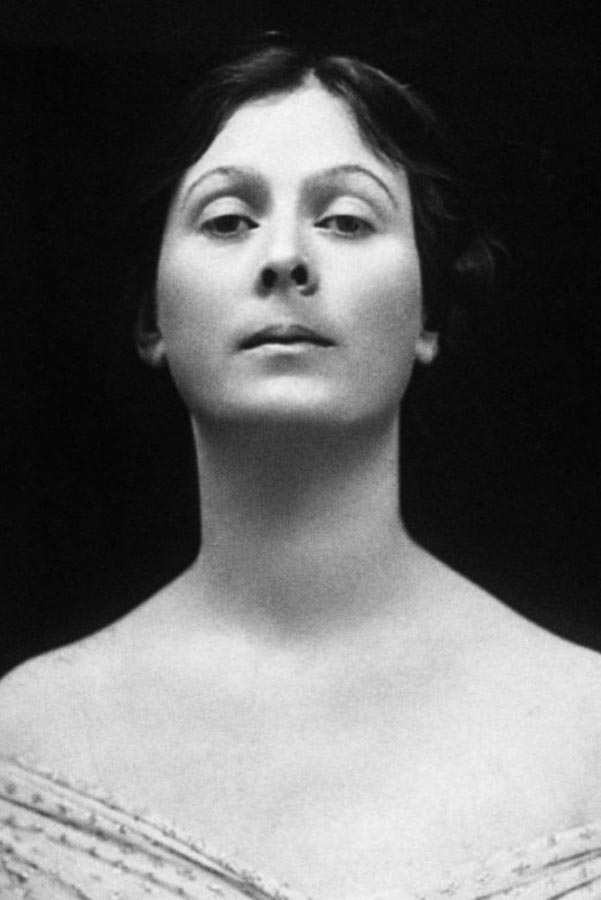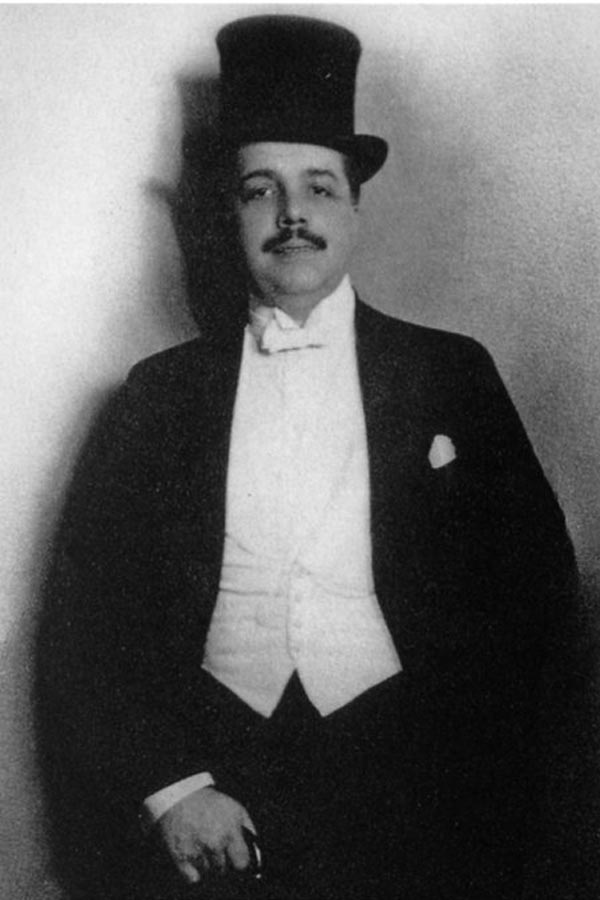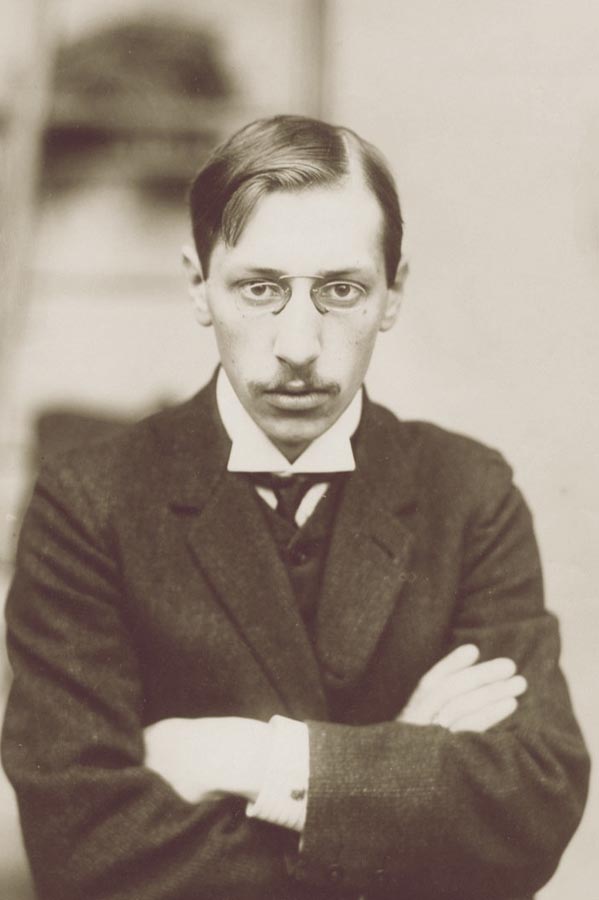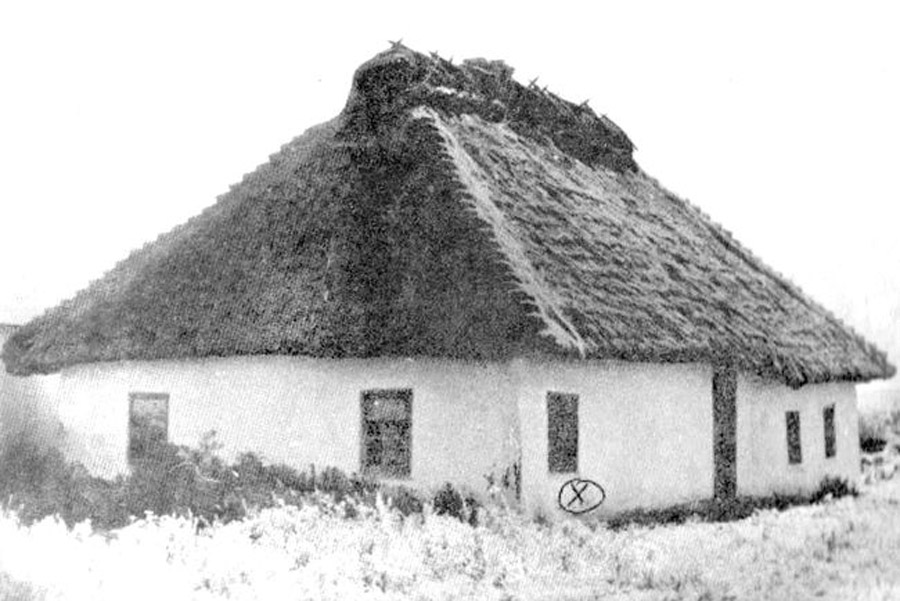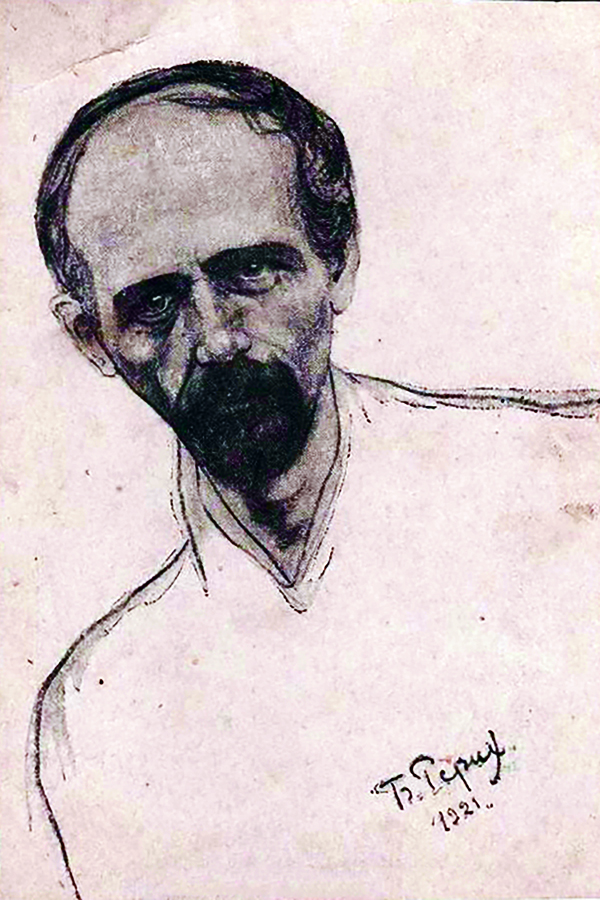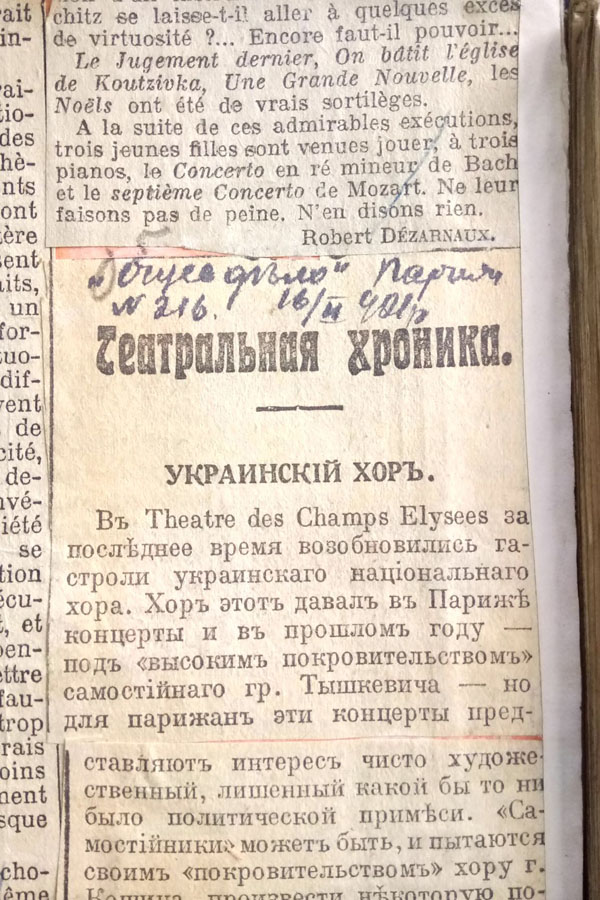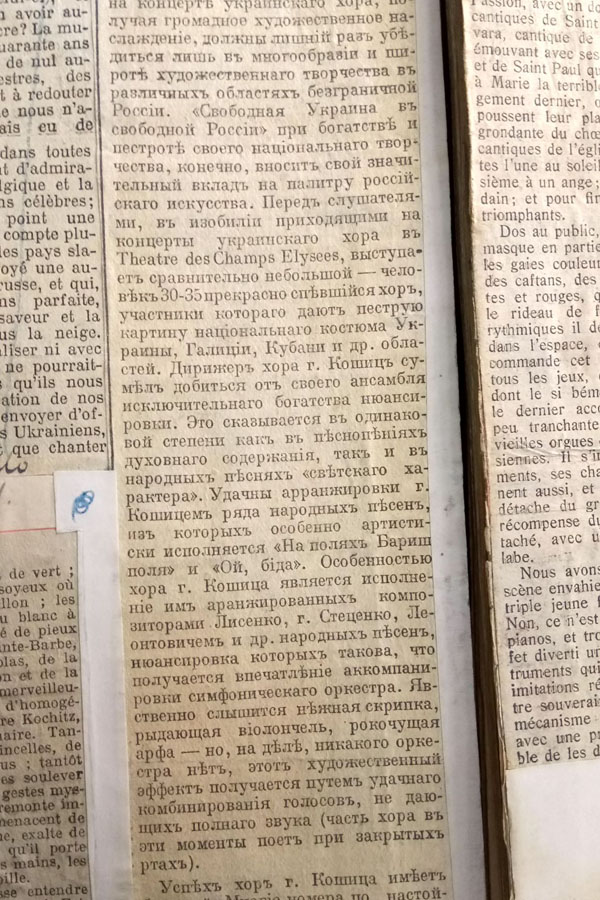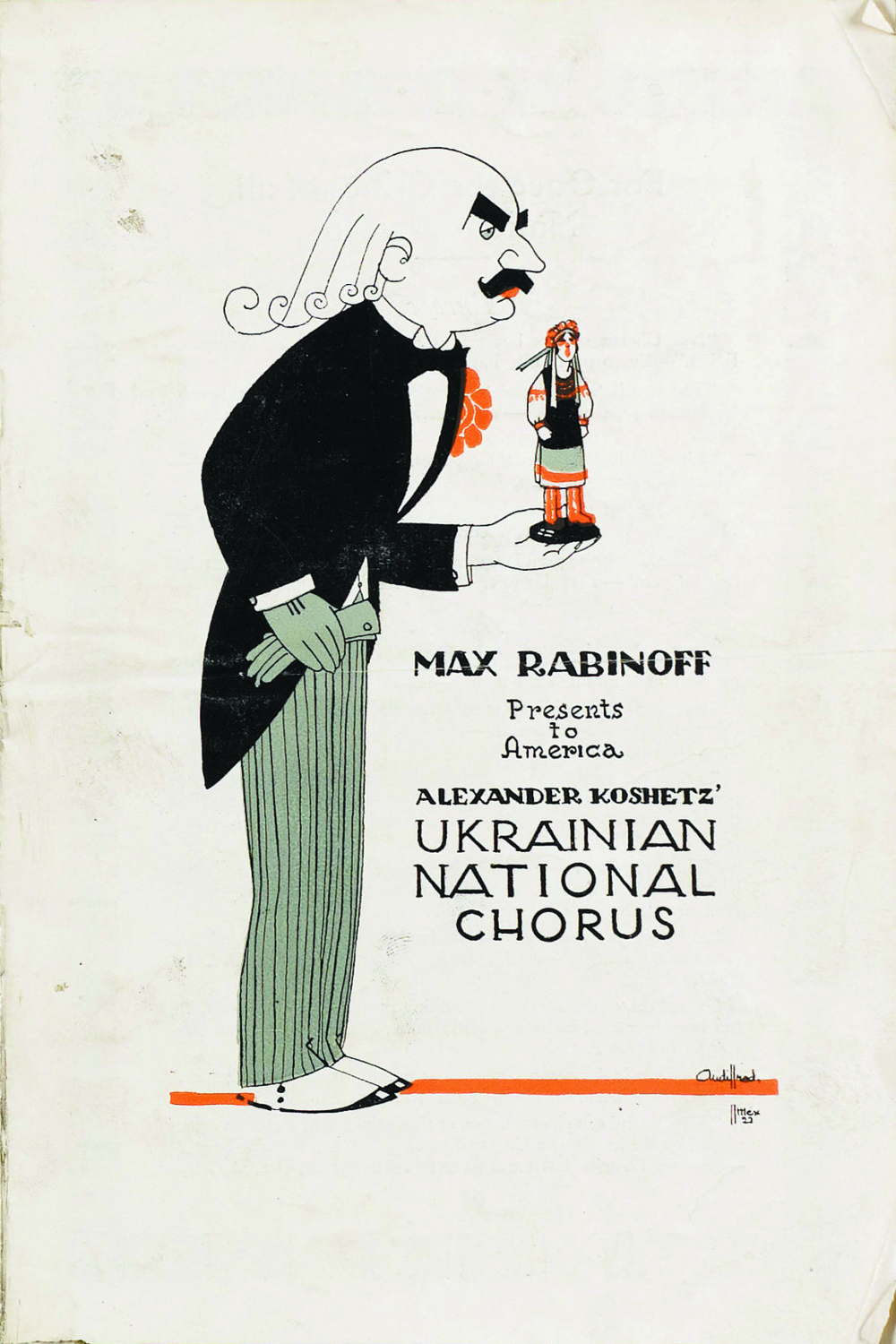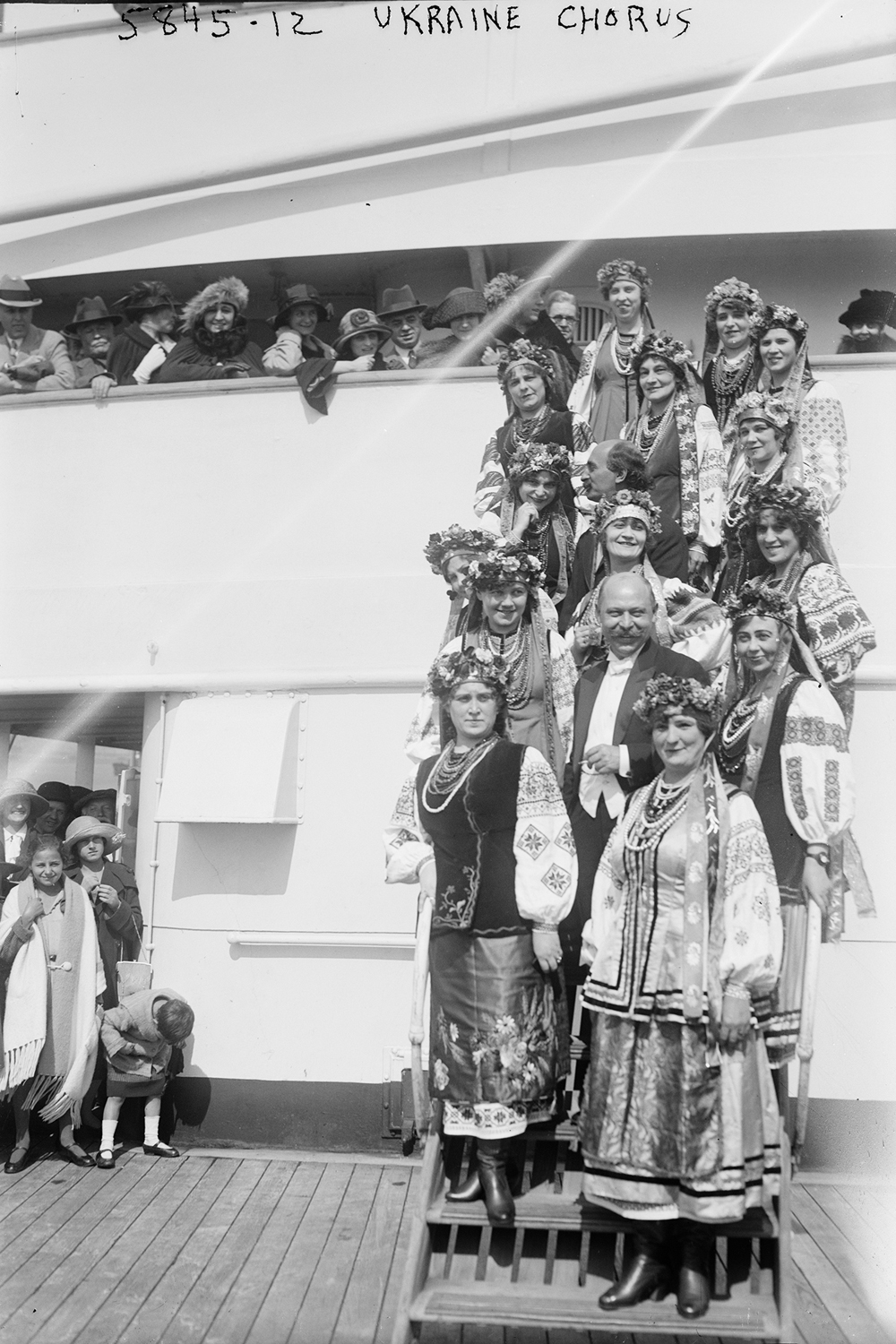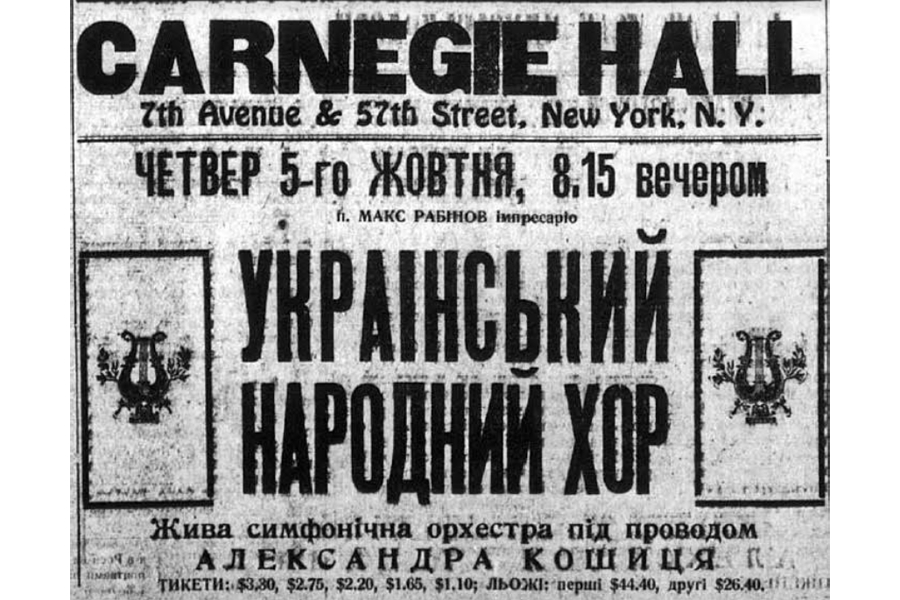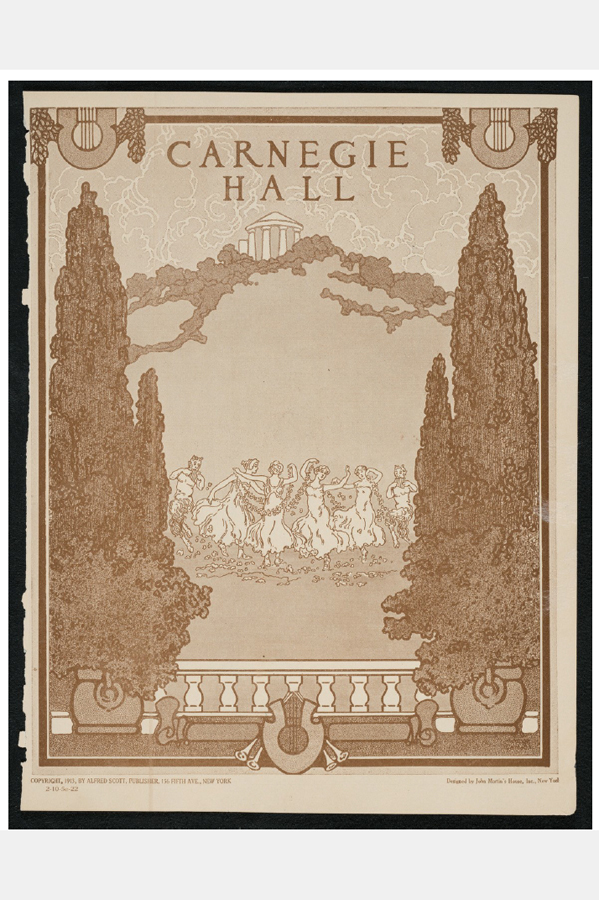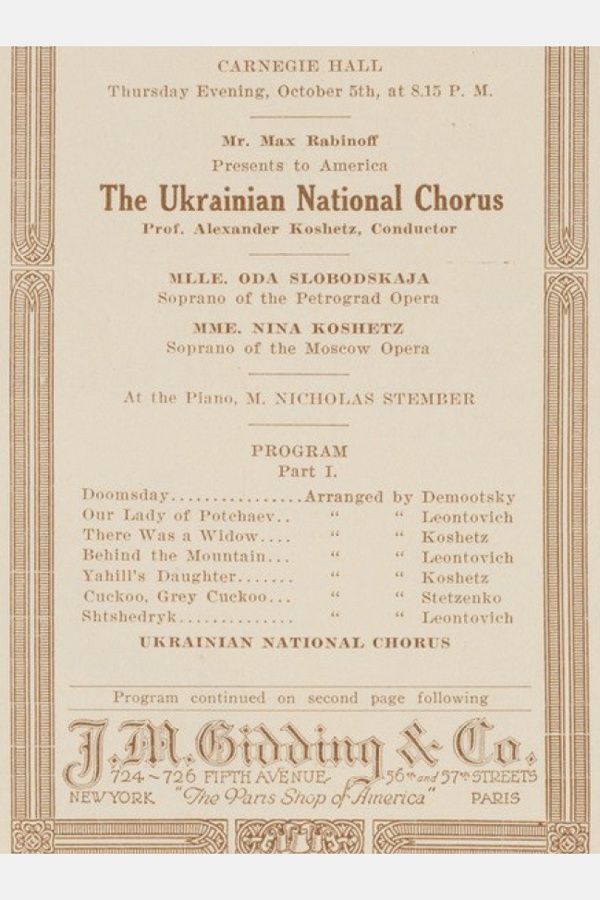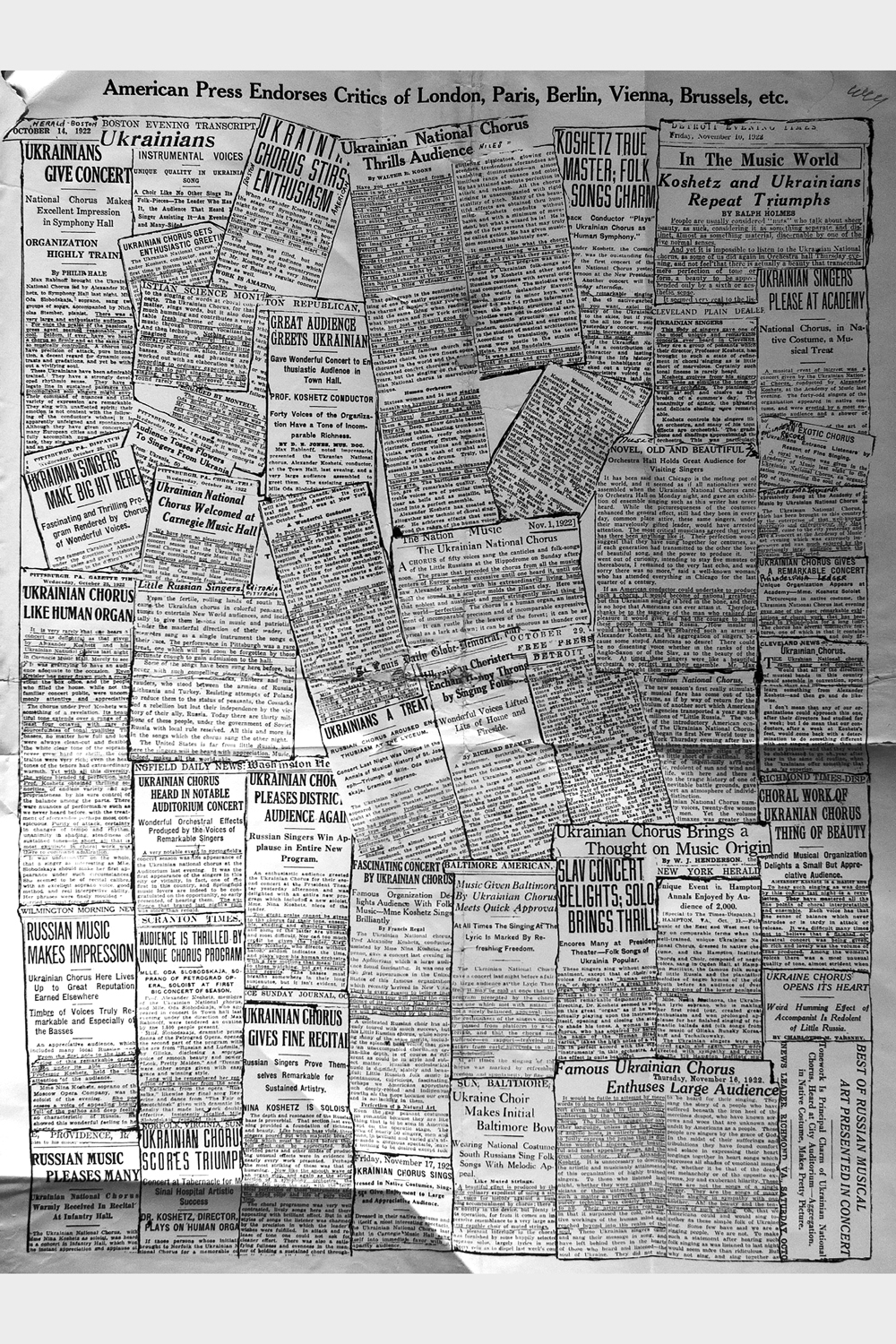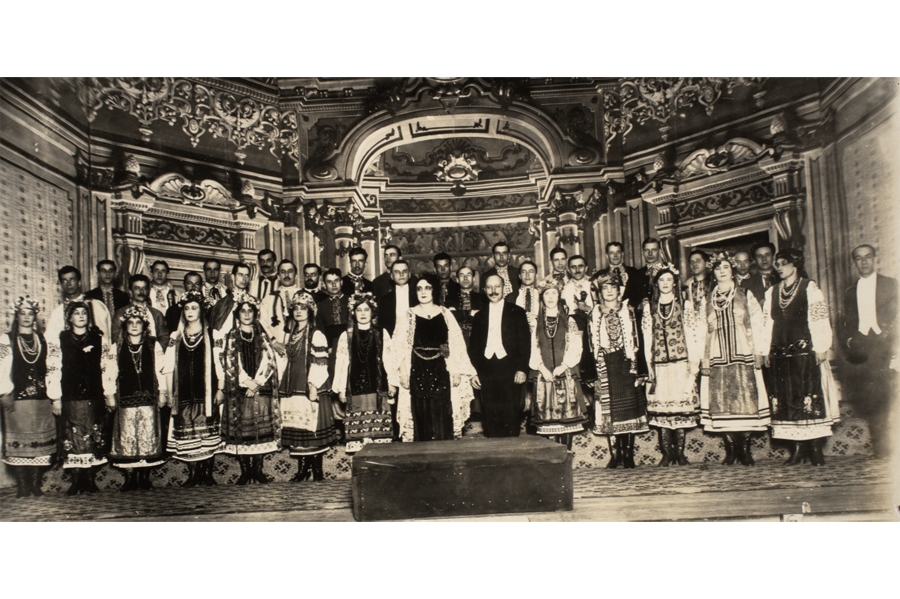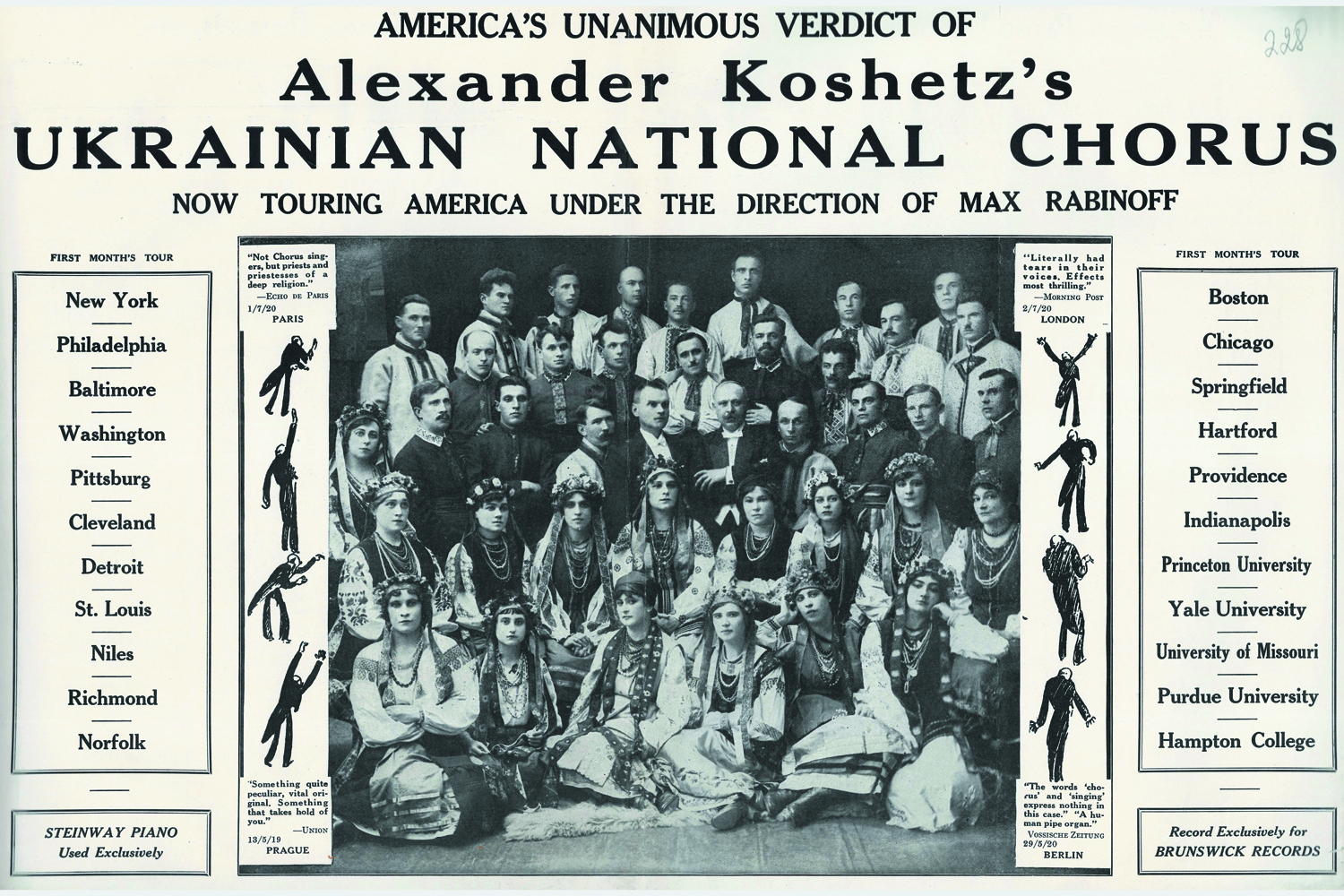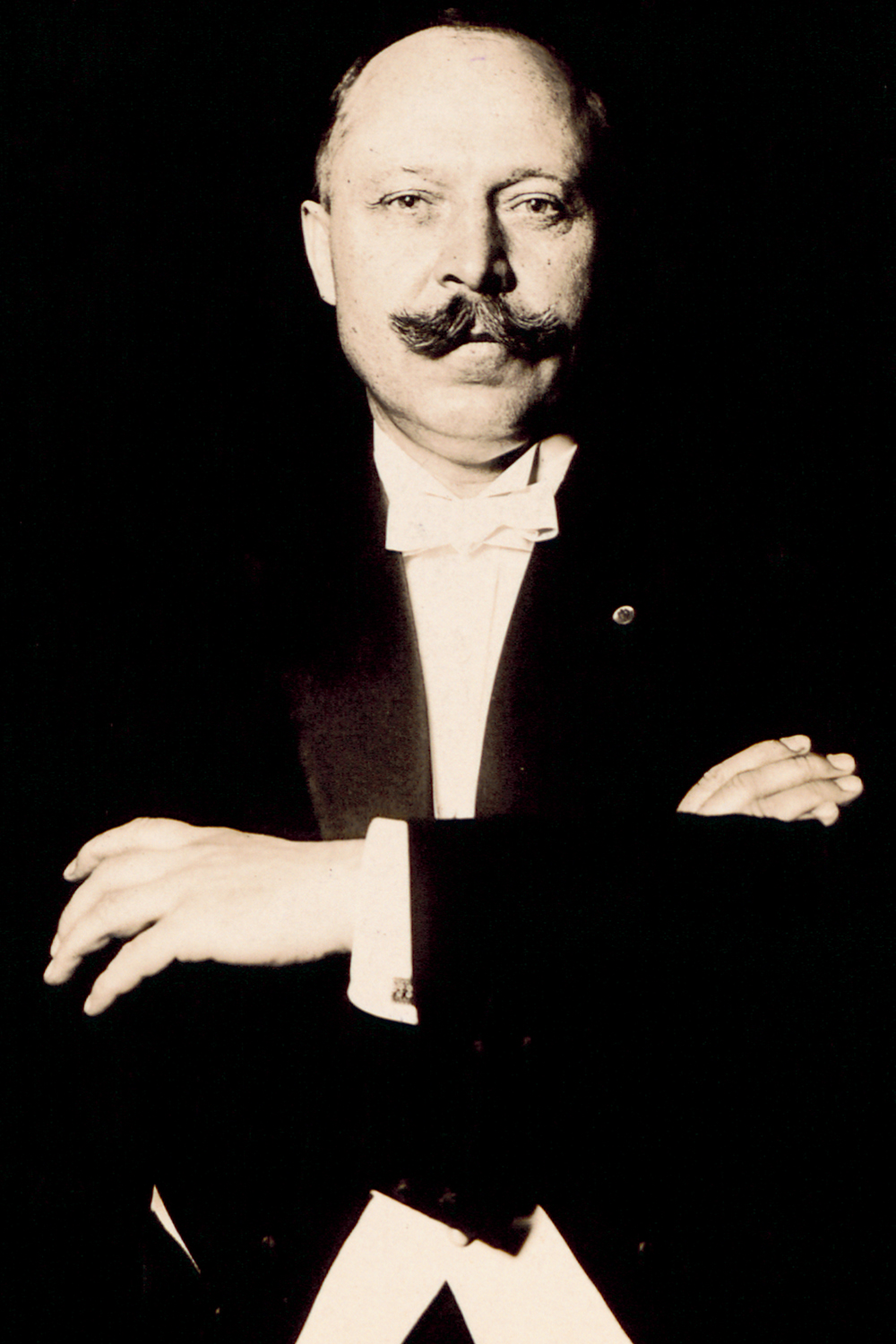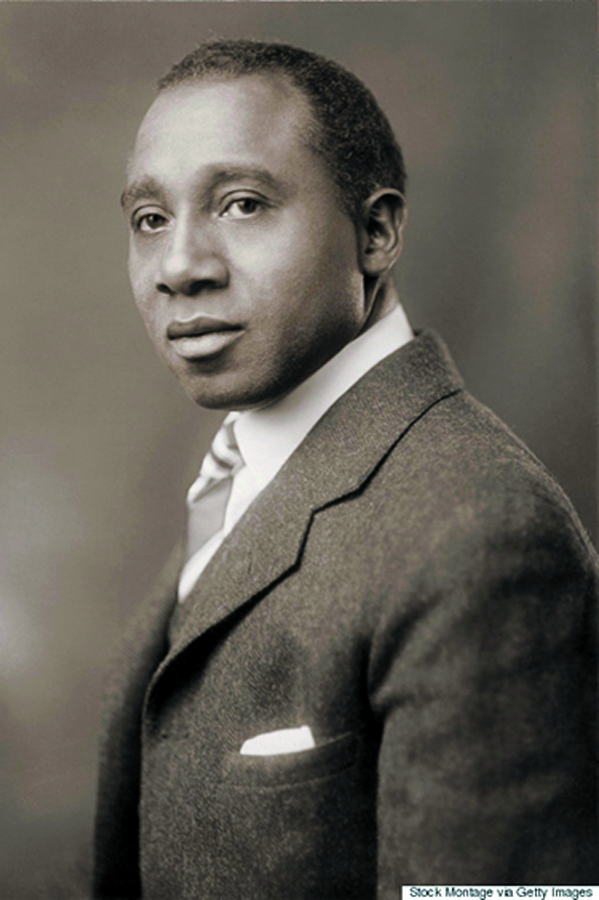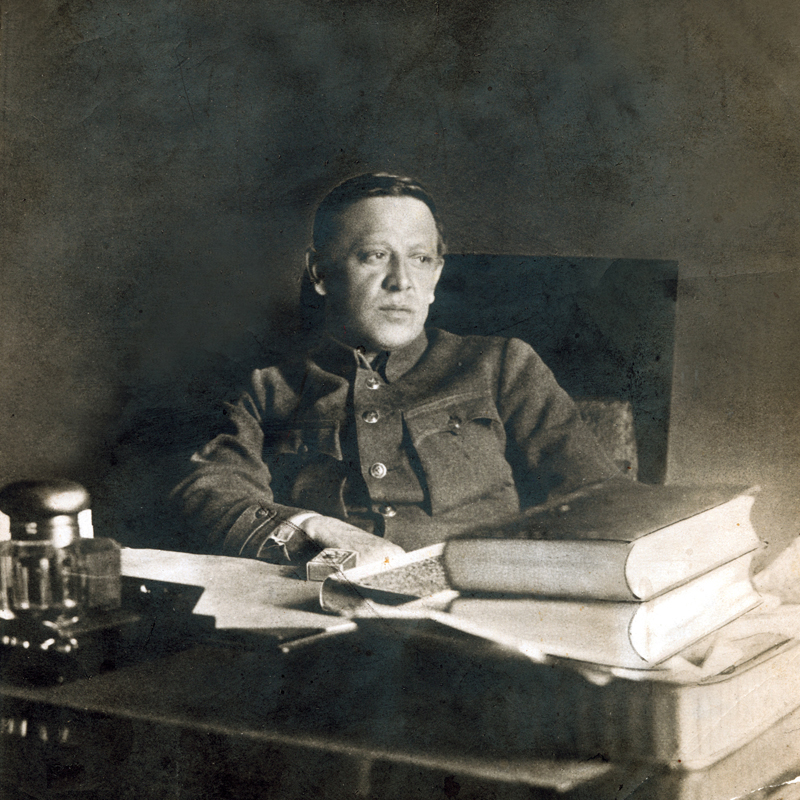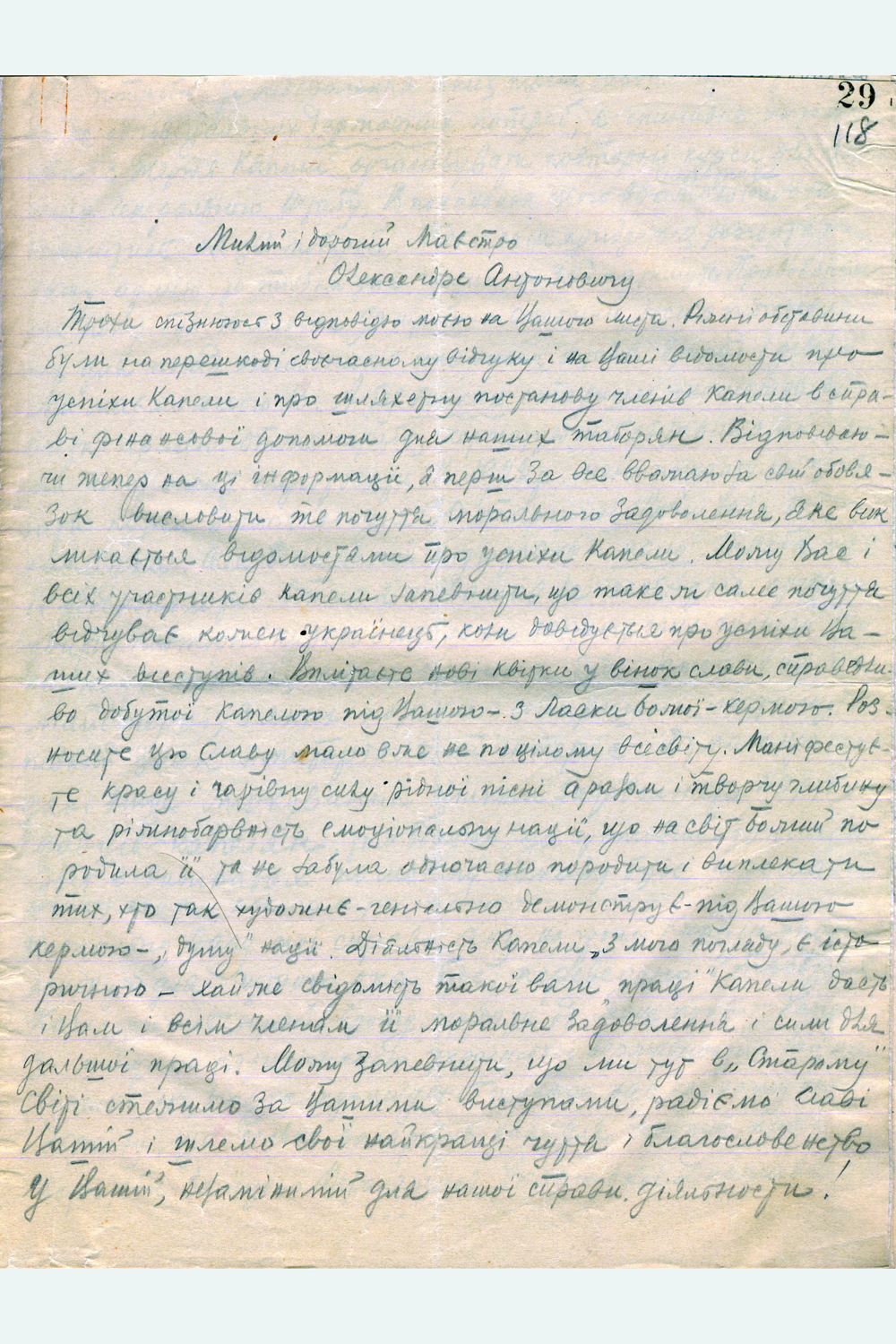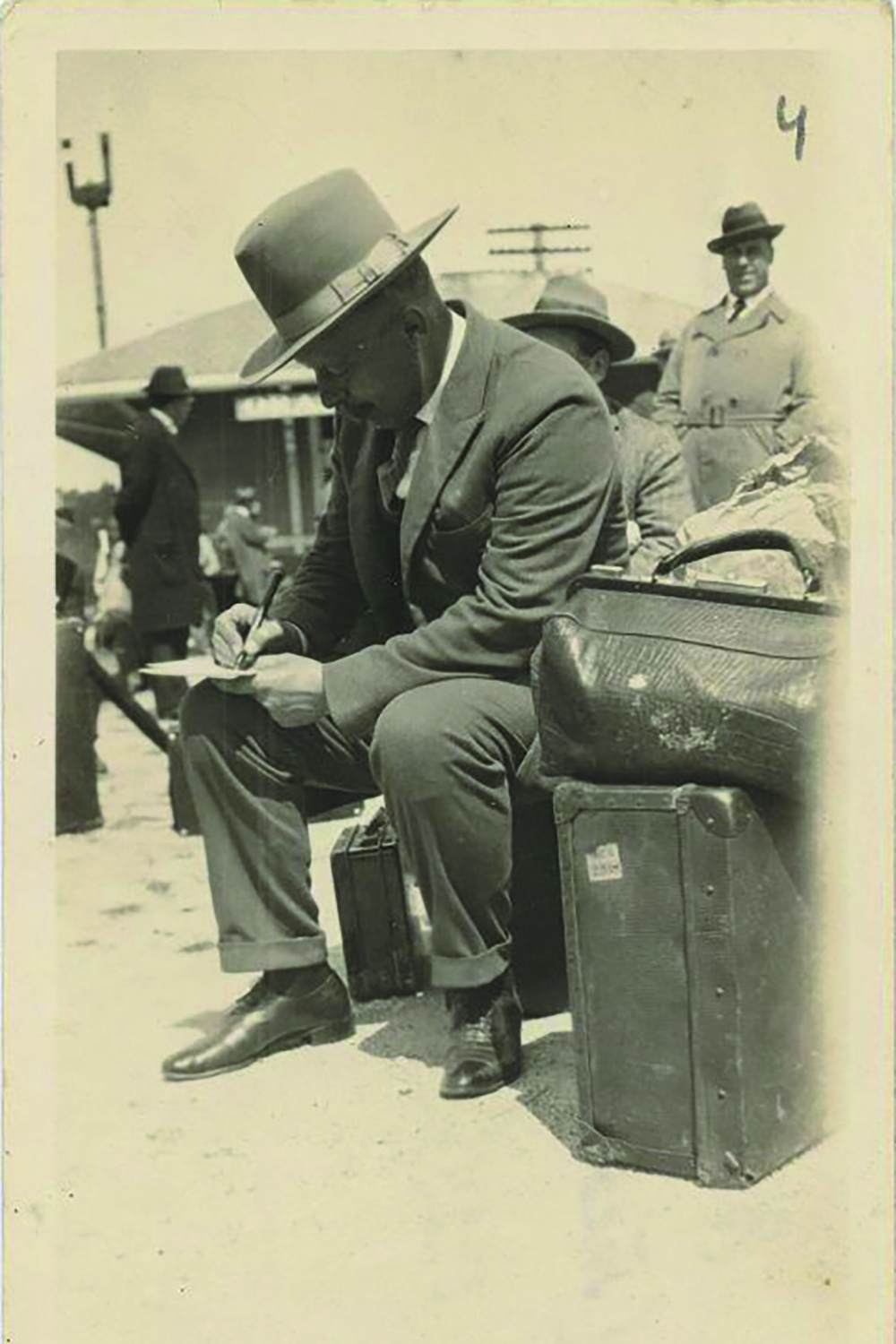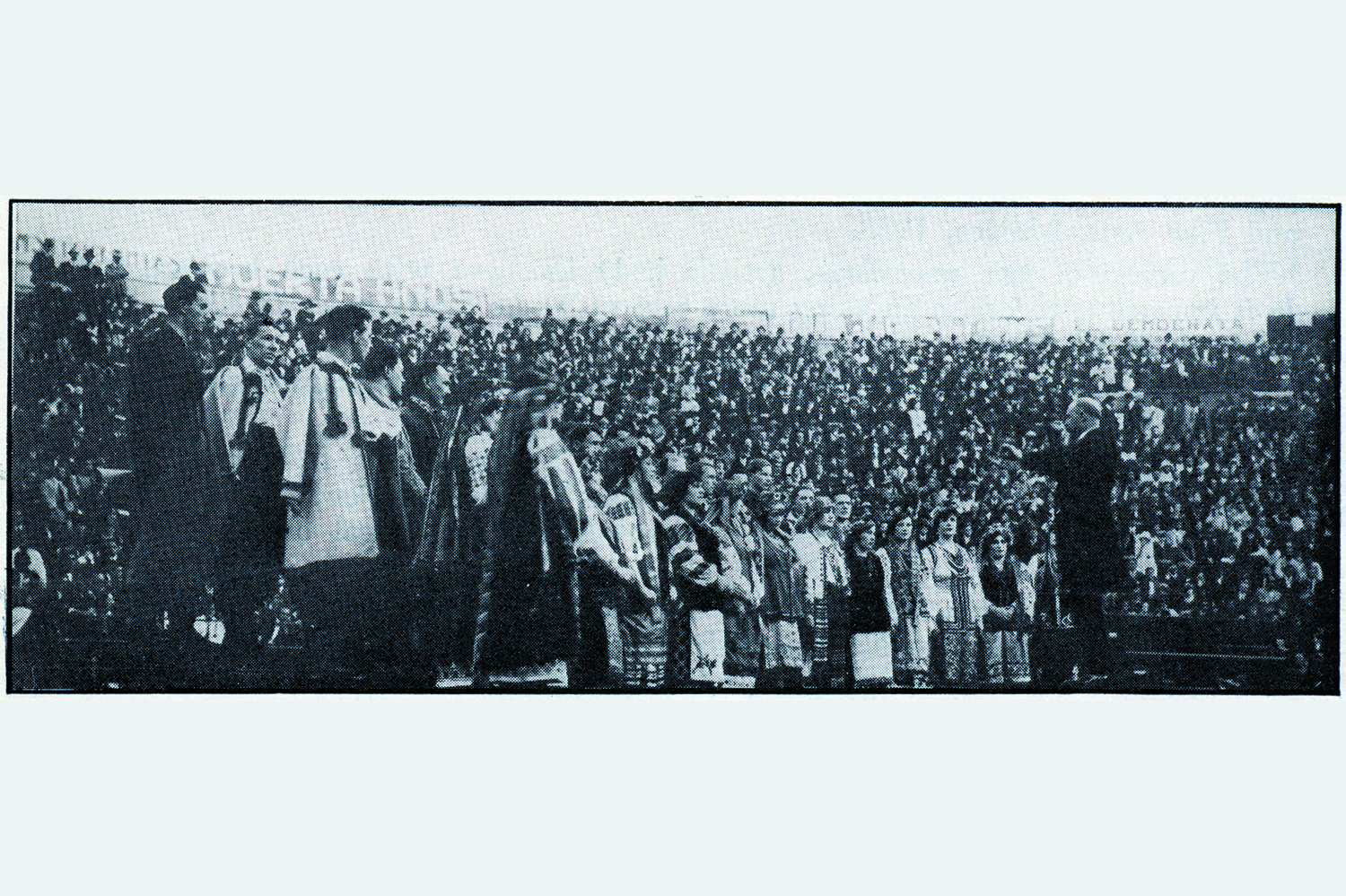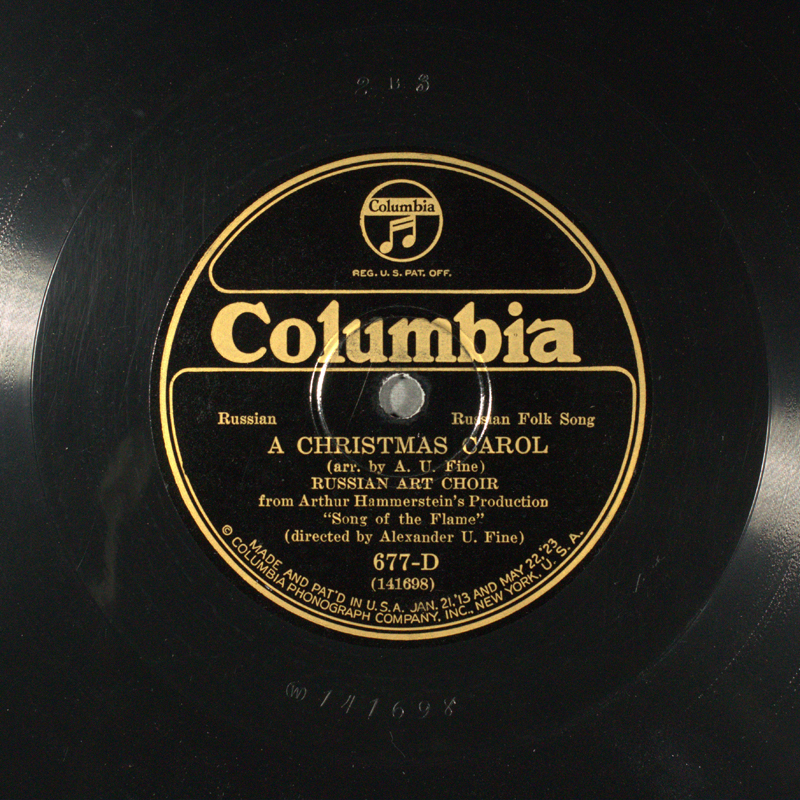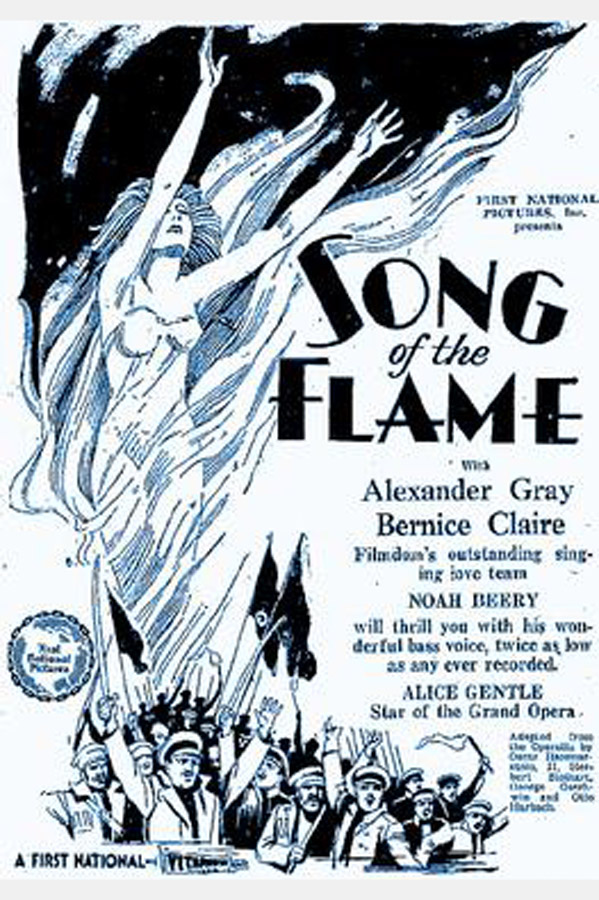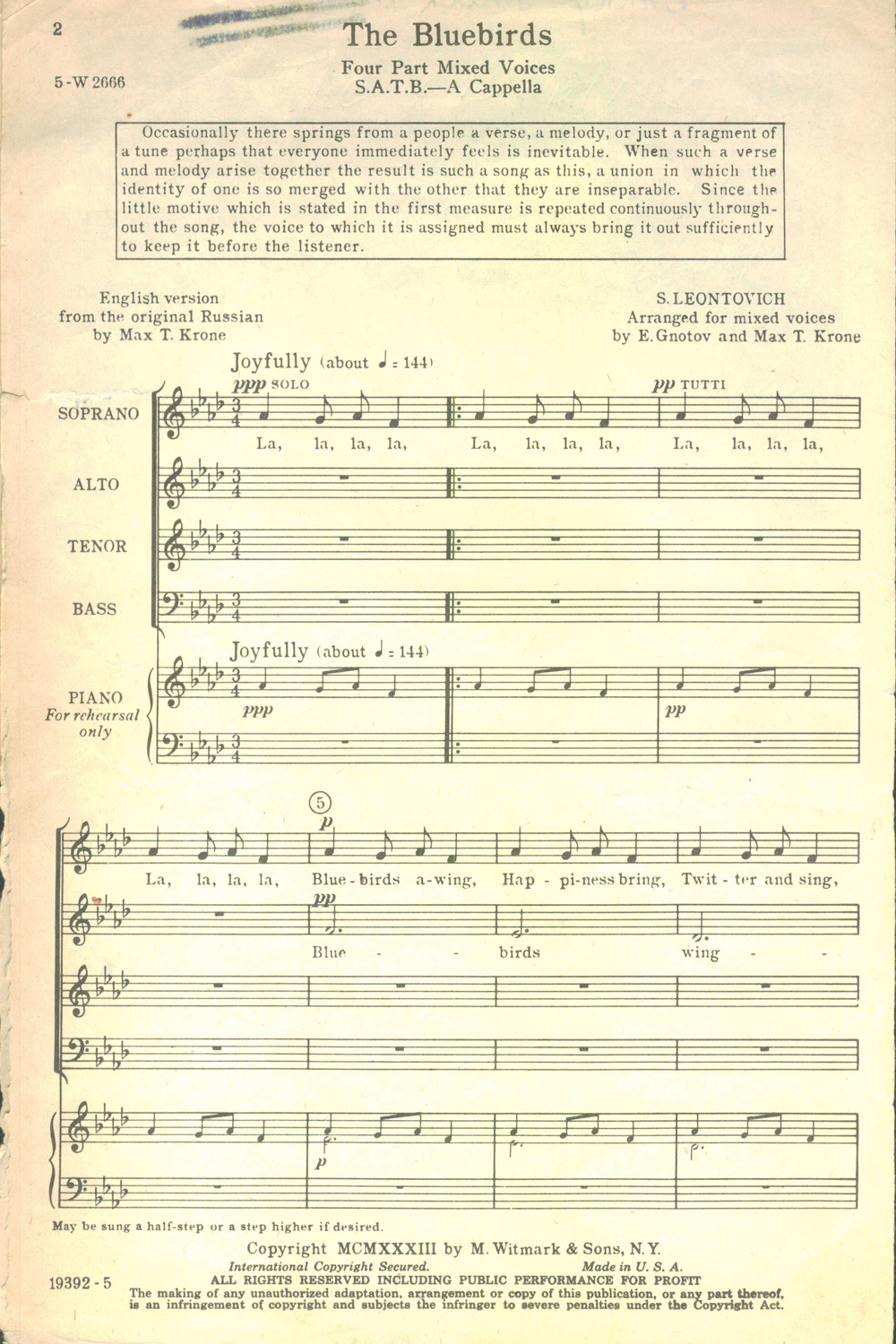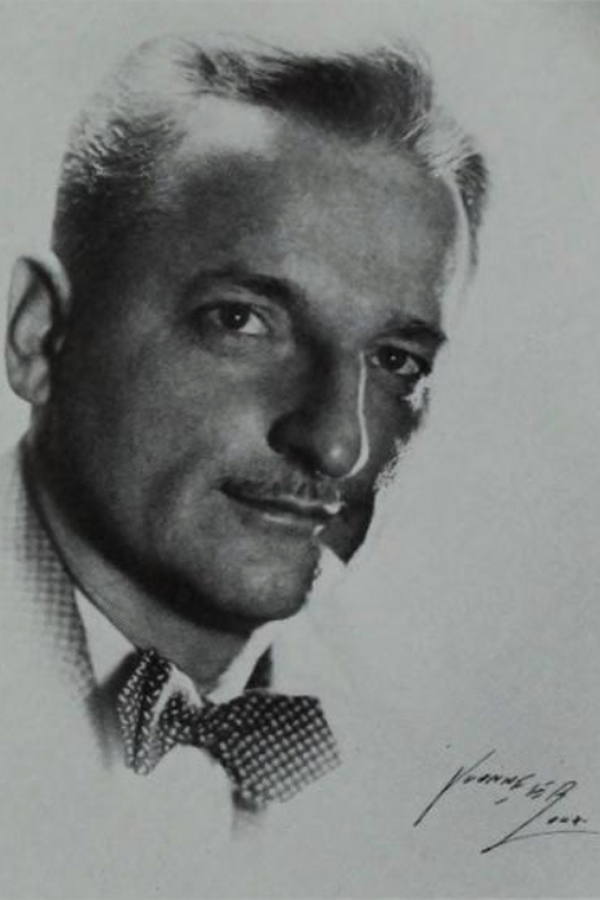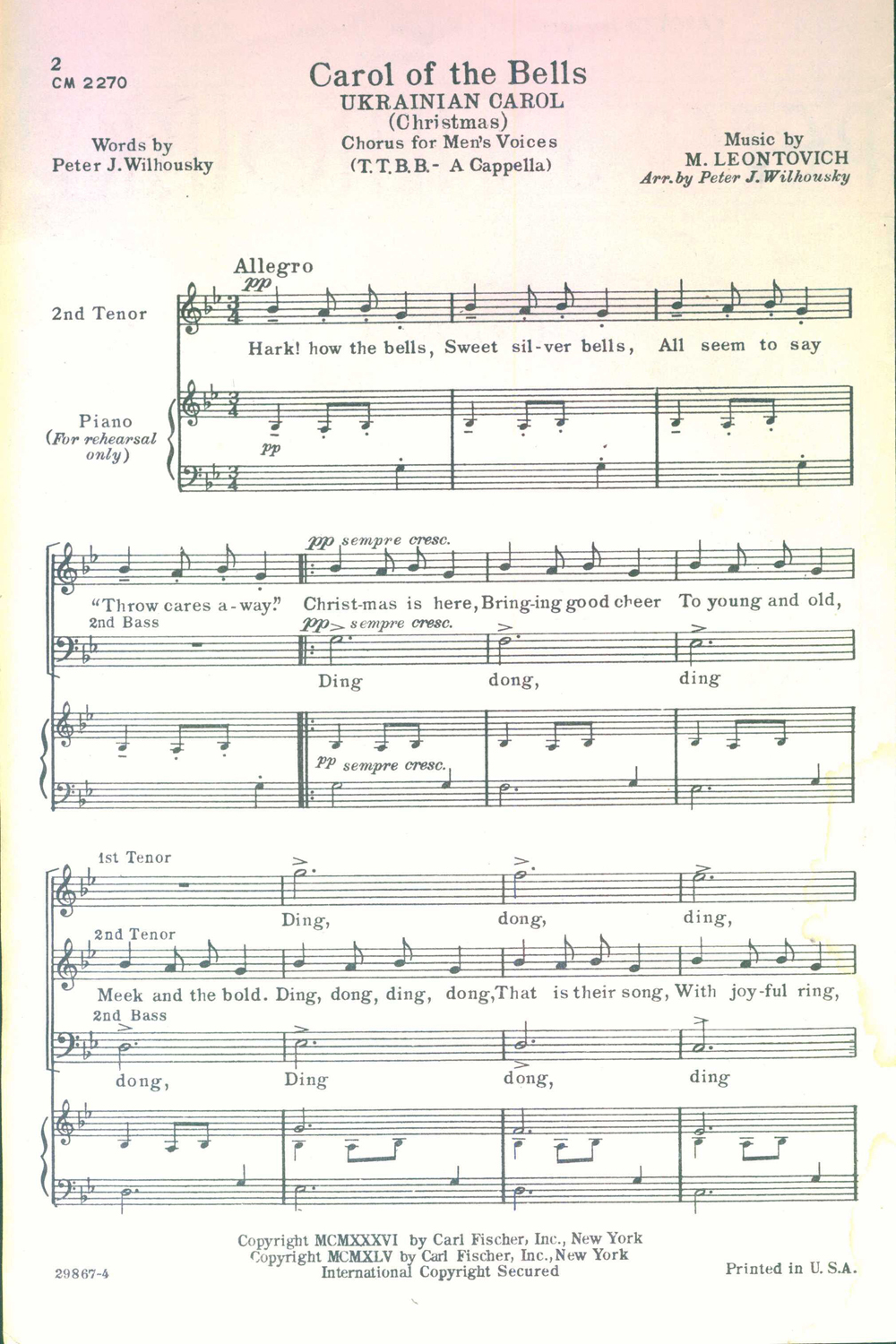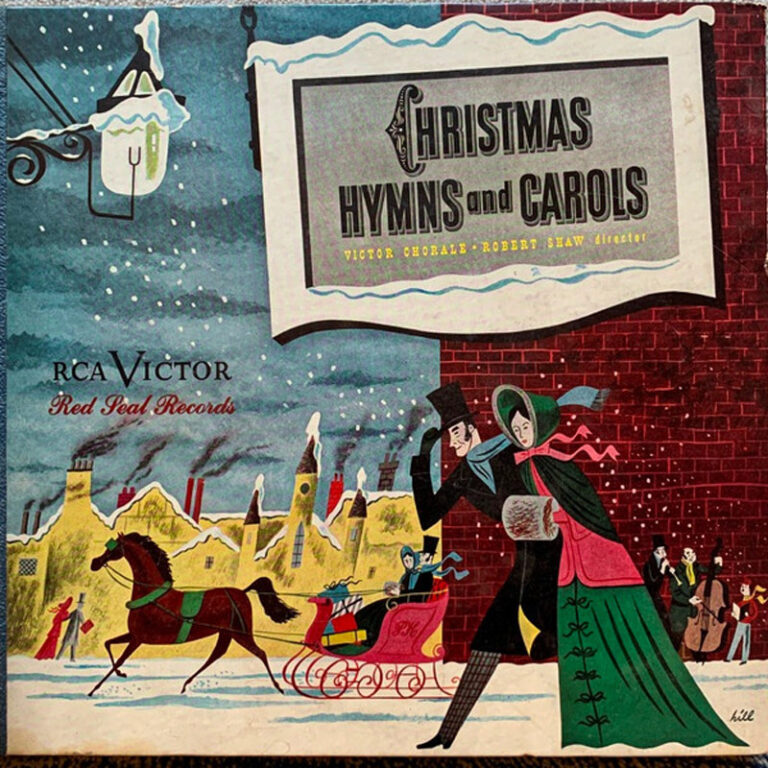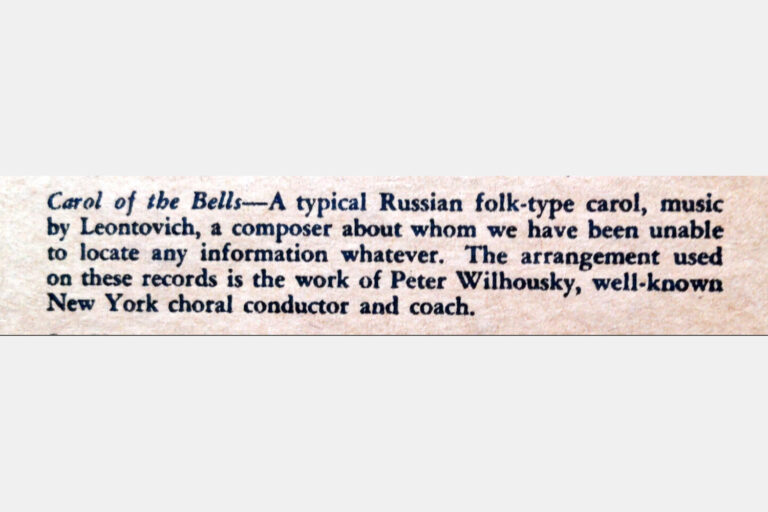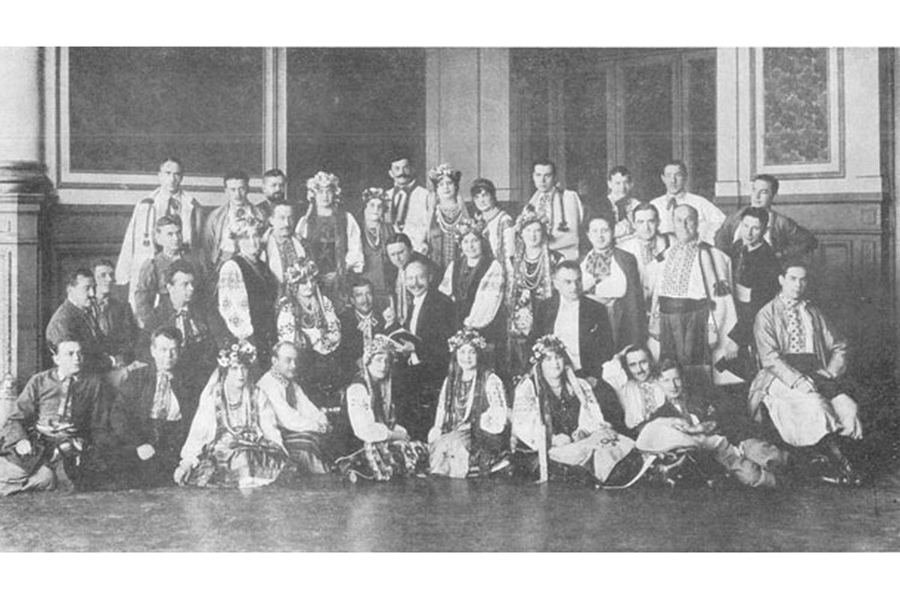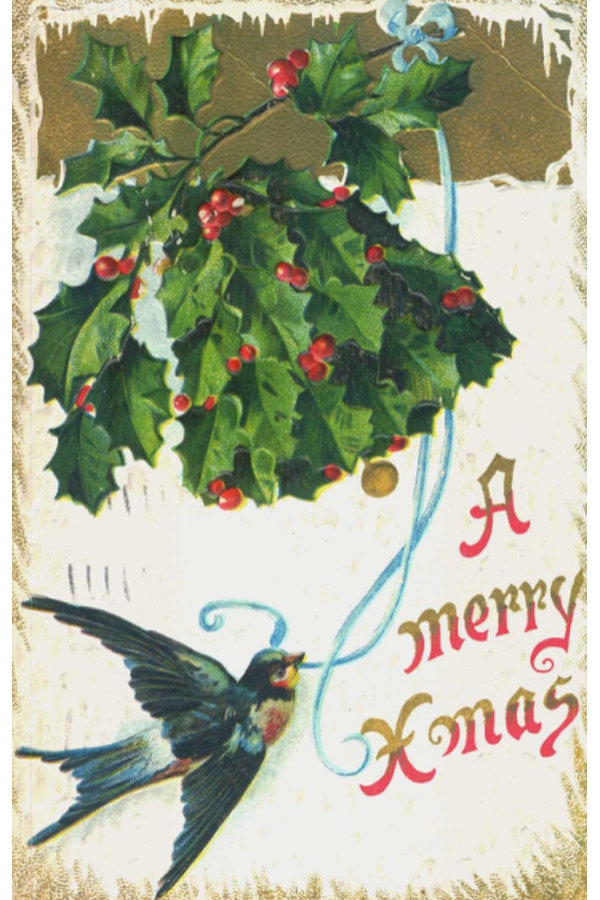“Carol of the Bells” has emerged as one of the most well-known Christmas songs across various parts of the world. However, it is less commonly known that this song was actually created by Ukrainian composer Mykola Leontovych and is deeply rooted in an ancient song known as “Shchedryk”, dating back to pre-Christian times.
For many years, “Shchedryk” has been a staple in every Ukrainian home and graced the stages of the world’s most esteemed concert venues. It has also evolved into a symbol of the Ukrainians’ prolonged struggle for independence from Russia. The English version, “Carol of the Bells”, appeared only in 1936.
*
Most of the research material is published for the first time, its reprinting and use is allowed only with the author’s permission ([email protected]).This article unveils the hidden story behind one of the world’s most famous Christmas songs. This exploration has become possible thanks to newly accessed archival materials, which had been off-limits for over fifty years. The research was led by Tina Peresunko, a researcher at the Mykhailo Hrushevsky Institute of Ukrainian Archaeology and Source Studies of the National Academy of Sciences of Ukraine, the founder of the Leontovych Institute and the author of the book “Cultural Diplomacy of Symon Petliura: ‘Shchedryk’ against the Russian World. The mission of Oleksandr Koshyts’ chapel (1919-1924)”. For the first time, she delves into the international journey of “Shchedryk”, illustrating how its centuries-old legacy continues to resonate in the present.
“I’m not complaining. For a true artist, the living
testament should be to work at full capacity under any circumstances”.
Mykola Leontovych
This song has evolved into a symbol of Christmas, enchanting people worldwide. Performed by some of the world’s most renowned musicians, it has graced movies and commercials alike. Even NBA basketball players have embraced its rhythm. “Carol of the Bells” truly brings joy to all nations that celebrate Christmas, resonating with a spirit of festivity and harmony.
From a “shchedrivka” worship song to a Christmas carol
“Carol of the Bells” is a Ukrainian Christmas carol; music by M. Leontovych; words and arrangements by P. Wilhousky. This is indicated in the score, which was published in New York in 1936 by music publisher Carl Fisher. The same is true of the many notes of “Carol of the Bells”, which are played every year for Christmas by performers worldwide. Surprisingly enough, this piece of music has nothing to do with Christmas, is not a Christmas song, nor is it originally related to winter.
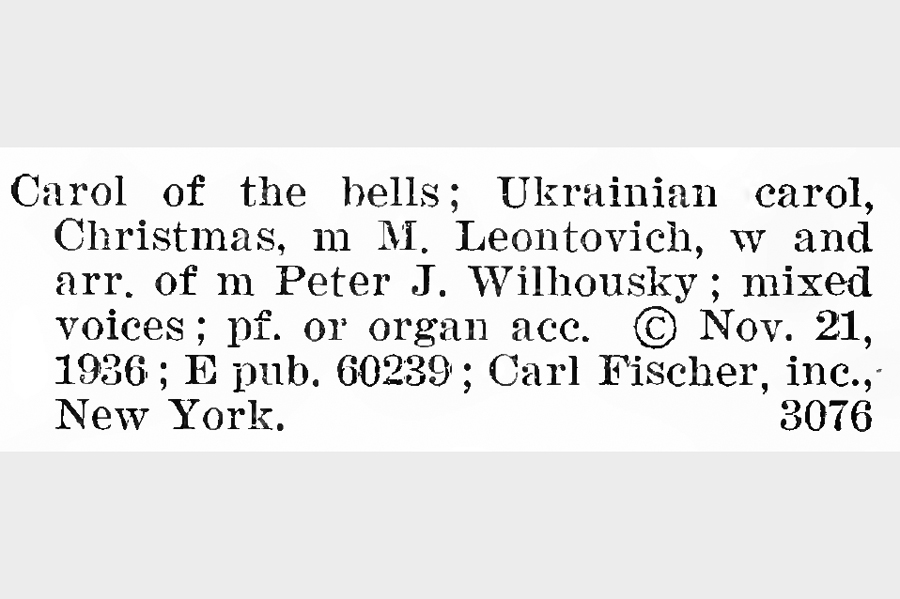
Extract from the catalogue of the United States Copyright Office, 1937
“Shchedryk” is an old Ukrainian ritual song that was sung in March, when the swallows came home. It belongs to the genre of Ukrainian New Year’s songs, which were performed on the territory of ancient Ukraine before the adoption of Christianity. Back then, the New Year was celebrated in the country in March. Therefore, in the original text, unlike the English version, it refers to the swallows, not the bells, and the actual name of the song is “Shchedryk” from the word “shchedryi”, which means generosity, fertility, life-giving. For centuries, it was a simple one-voice melody of four notes.
“Shchedryk” was sung on Christmas Eve, when the whole family gathered around the table to celebrate the New Year. People would set the table with different meals and “shchedrivniky” (young people or children) would go from house to house singing worship songs beneath the windows:
Shchedryk, shchedryk, shchedrivochka
Here flew the swallow from afar
Started to sing lively and loud
Asking the master to come out
Come here, oh come, master — it’s time
In the sheepfold wonders to find
Your lovely sheep have given birth
To little lambs of great worth
All of your wares are very fine
Coin you will have in a big pile
All of your wares are very fine
Coin you will have in a big pile
You have a wife
Fair as a dove
If not the coin, then the chaff
You have a wife fair as a dove
Literal translation by Olena Androsova
Unlike the similar Christmas carolling, where the main point was the celebration of Christ’s birth, “shchedrivka” songs were praising and worshipping the host, his wife and children, wishing the family prosperity, a good harvest, and an increase in livestock in the new year. In return, “shchedrivniky” were rewarded with food or money.
With the New Year’s celebration being moved to the winter season, the “shchedrivka” began to be sung in January, the week after Christmas.
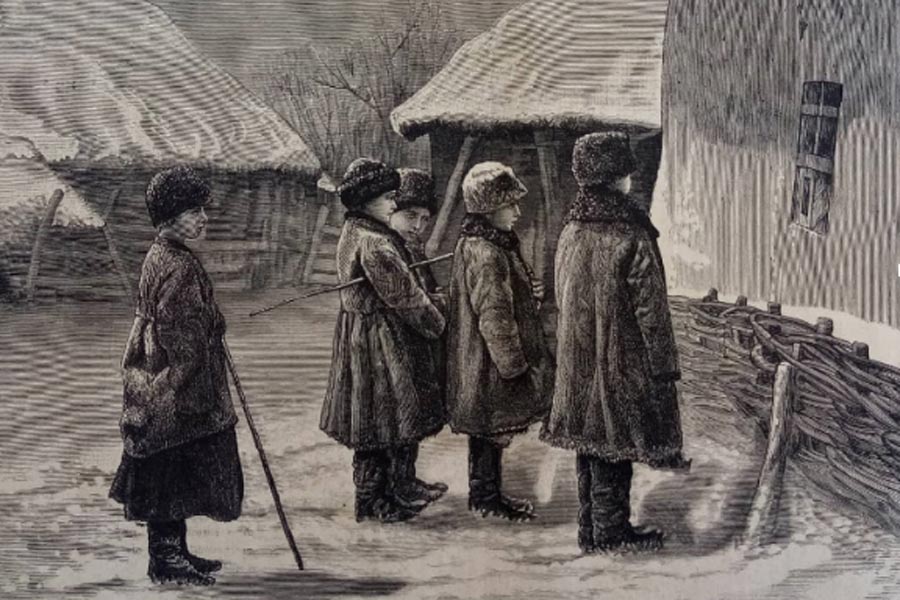
Fragment of a painting with Ukrainian Chirstmas carol singers, 1883 (from the private collection of Anatoliy Paladiychuk)
The appearance of “Shchedryk” in the edited version by Mykola Leontovych
The song remained in Ukrainian folklore for a long time until the turn of the XX century when Ukrainian composer Mykola Leontovych (1877-1921) heard it. Based on a simple one-voice melody, he wrote the choral masterpiece that is now sung at Christmas around the world.
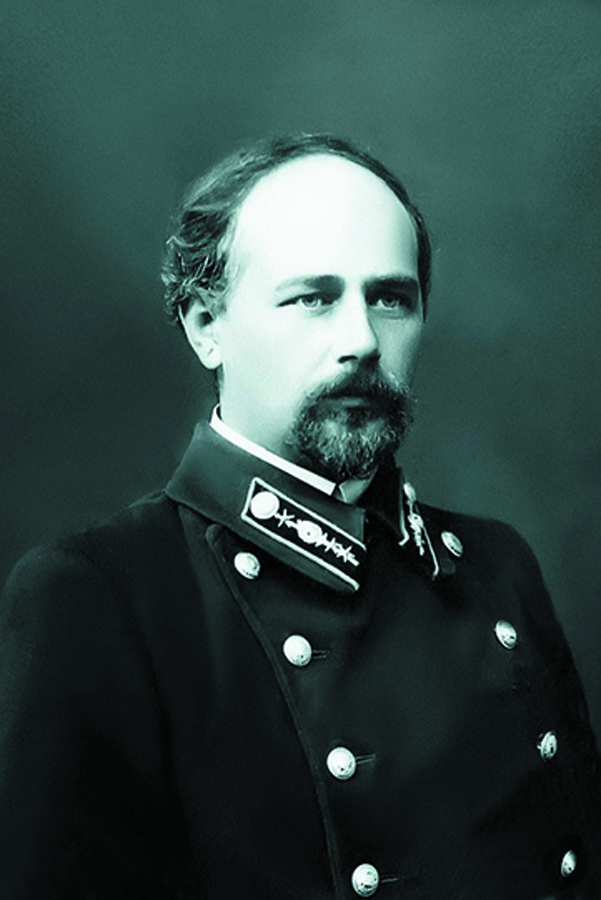
Ukrainian composer Mykola Leontovych, creator of the “Carol of the Bells” melody.
The composer set out to create the future Christmas hit in 1910. Then, on the advice of the professor of the Kyiv Conservatory Boleslav Yavorsky, he developed the ostinato motif effect in “Shchedryk”, the same principle of repetition of the main melody of the song (the first four notes). This would then be used by different performers of “Carol of the Bells”.
For the lyrics of the song, Mykola Leontovych took the Volyn variant of “Shchedryk”, which was recorded by folklorists in the city of Krasnopyl in the Polissia region and published in one of the collections of Ukrainian songs. The popular worship song may have also been heard in the Podillia region, the composer’s homeland. He may have sung it as a child.
Many Ukrainian composers of that era admired Ukrainian folklore. They travelled to villages, recorded folk songs from the local people, and created their choral works inspired by these melodies. During his studies at the Podillia Seminary, Mykola Leontovych undertook numerous folklore expeditions, creating over a hundred choral masterpieces. Most Ukrainian folk songs exhibited excellent polyphony, characterised by the harmony of multiple voices. The composers further refined this quality. However, the musical character of some works, particularly “Shchedryk”, was quite simple. Thus, adapting it involved crafting an entirely independent musical piece.
Mykola Leontovych worked on his masterpiece for years. Only six years later, in August 1916, he sent the manuscript of “Shchedryk” (songs for an a cappella mixed choir) to the well-known Kyiv conductor Oleksandr Koshyts. A few months later, the song was first played in Kyiv.
Mixed choir
A choir composed of both male and female voices.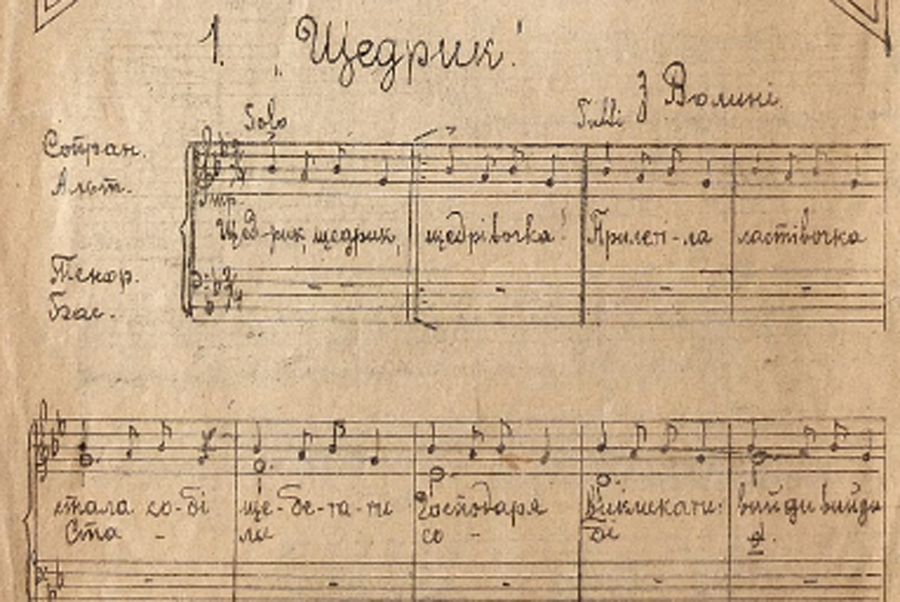
Fragment of the page of the first edition of “Shchedryk” by Mykola Leontovych, 1918
The premiere of “Shchedryk” took place on the 29th of December 1916 during a Christmas concert in the hall of the Merchants Council building (now the National Philharmonic Orchestra of Ukraine). The song was performed by the student choir of St. Volodymyr University of Kyiv under the direction of Oleksandr Koshyts. The conductor recalled that the performance was very successful, and the song immediately appealed to the audience.
But how did “Shchedryk” get overseas? This is where we switch from culture to politics.
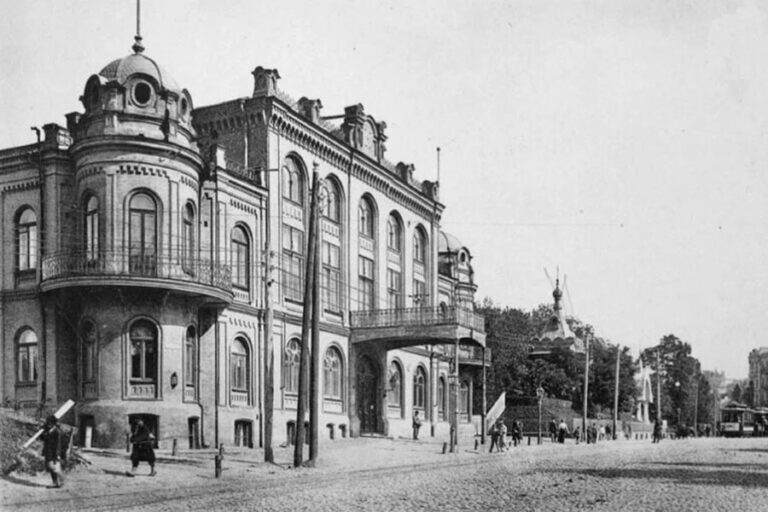
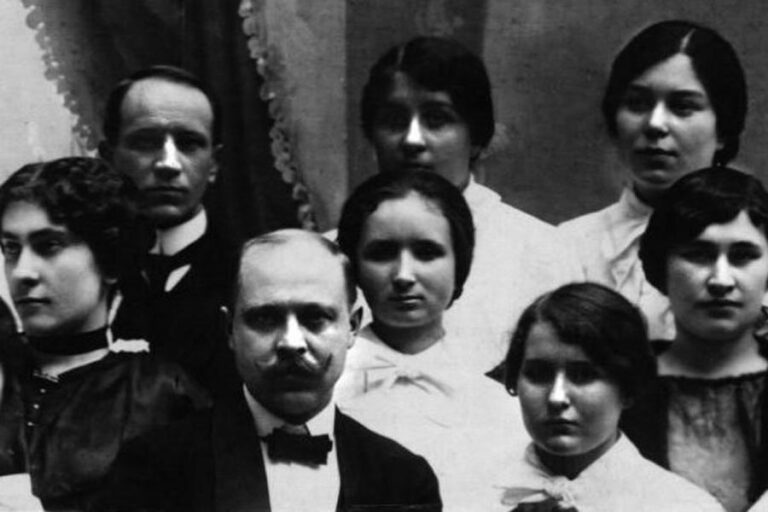
slideshow
“Shchedryk” in the struggle for Ukraine’s independence
Three months after the Kyiv premiere, significant changes happened in Ukraine’s history. In February 1917, the Russian Empire, which at that time included Ukrainian lands, experienced an October revolution. The Russian Emperor Nicholas II abdicated, and the nations, enslaved by the empire, began their fight for independence.
Finland was the first to break out of the “prison of nations” by declaring independence in December 1917. The Ukrainian People’s Republic (UPR) was the second to proclaim independence on 22 January 1918. They were followed by the Baltic states, the South Caucasus, and Poland.
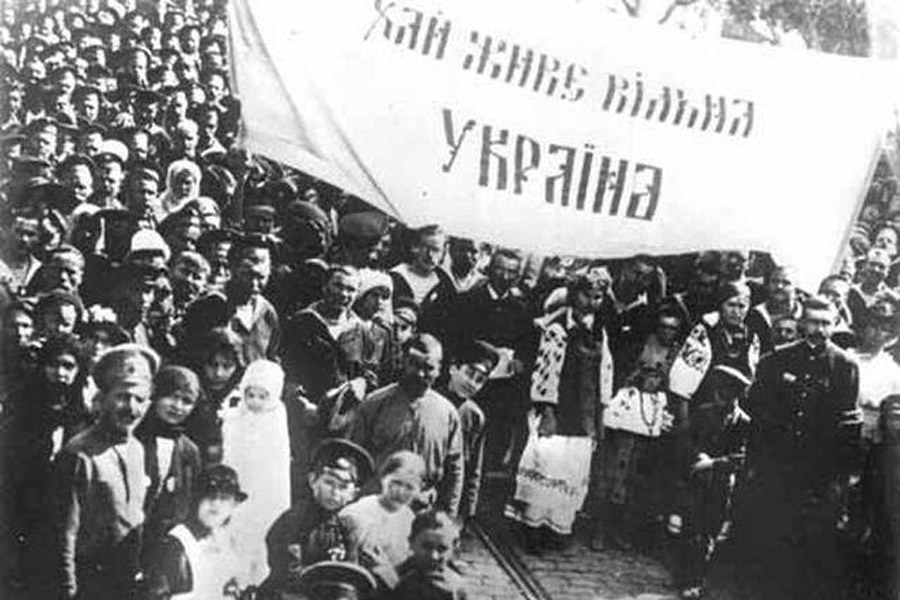
Ukrainian demonstration in Kyiv, 1918 Source: Central State Archives of Supreme Bodies of Power and Government of Ukraine
Immediately in Kyiv, the first national government was created, where Mykola Leontovych was invited to work. Together with the “godfather” of “Shchedryk”, Oleksandr Koshyts and other Ukrainian composers, he worked late nights in the music department of the Ukrainian Ministry of Education and Arts. Officials wrote and published Ukrainian music manuals, founded national choirs, and opened Ukrainian schools. Together, they did what would have been instantly banned by Tsarist Russia as a manifestation of “separatism”.
However, Ukrainian freedom did not last long. In October 1917, the Bolsheviks seized power in Moscow. Despite declaring the right of non-Russian nations for self-determination, they launched a hybrid war against states formed on the territory of the former Russian Empire. They occupied the territory of Ukraine, calling it its “liberation” from “chauvinism”.
The Bolsheviks
That's what the Russian Communists were called.“With the advance of our troops into the West and the Ukraine, regional provisional Soviet governments are being established to strengthen the Soviets in the field. This deprives the chauvinists of Ukraine, Lithuania, Latvia, and Estland (historical name of the north of Estonia — ed.) of considering the movement of our units as an occupation. Without this […] our troops in the occupied regions would not be welcomed by the population as liberators.”
Telegram from Vladimir Lenin to Ioakim Vatsetis, Chief of the Red Army, 29 November, 1918
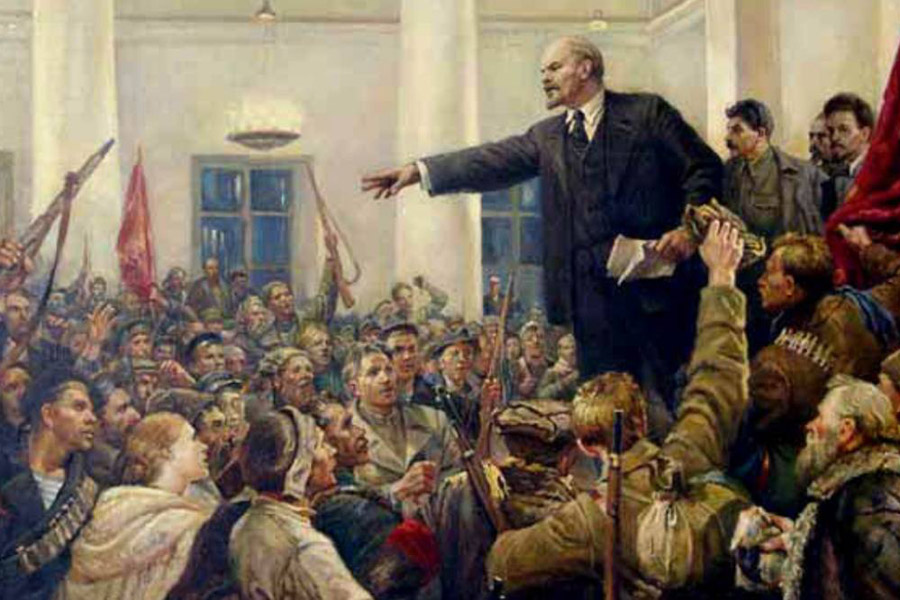
Fragment of a painting by Vladimir Serov, “Lenin proclaims the Soviet power”, 1947
At first, the “liberators” invaded Kharkiv, having proclaimed there a puppet Ukrainian People’s Republic of the Soviets. Soon, they launched the full-scale invasion of Kyiv. claiming that “they are not there”. They said it was an internal Ukrainian conflict: between the Kharkiv authorities and the government of the “Kyiv chauvinists”.
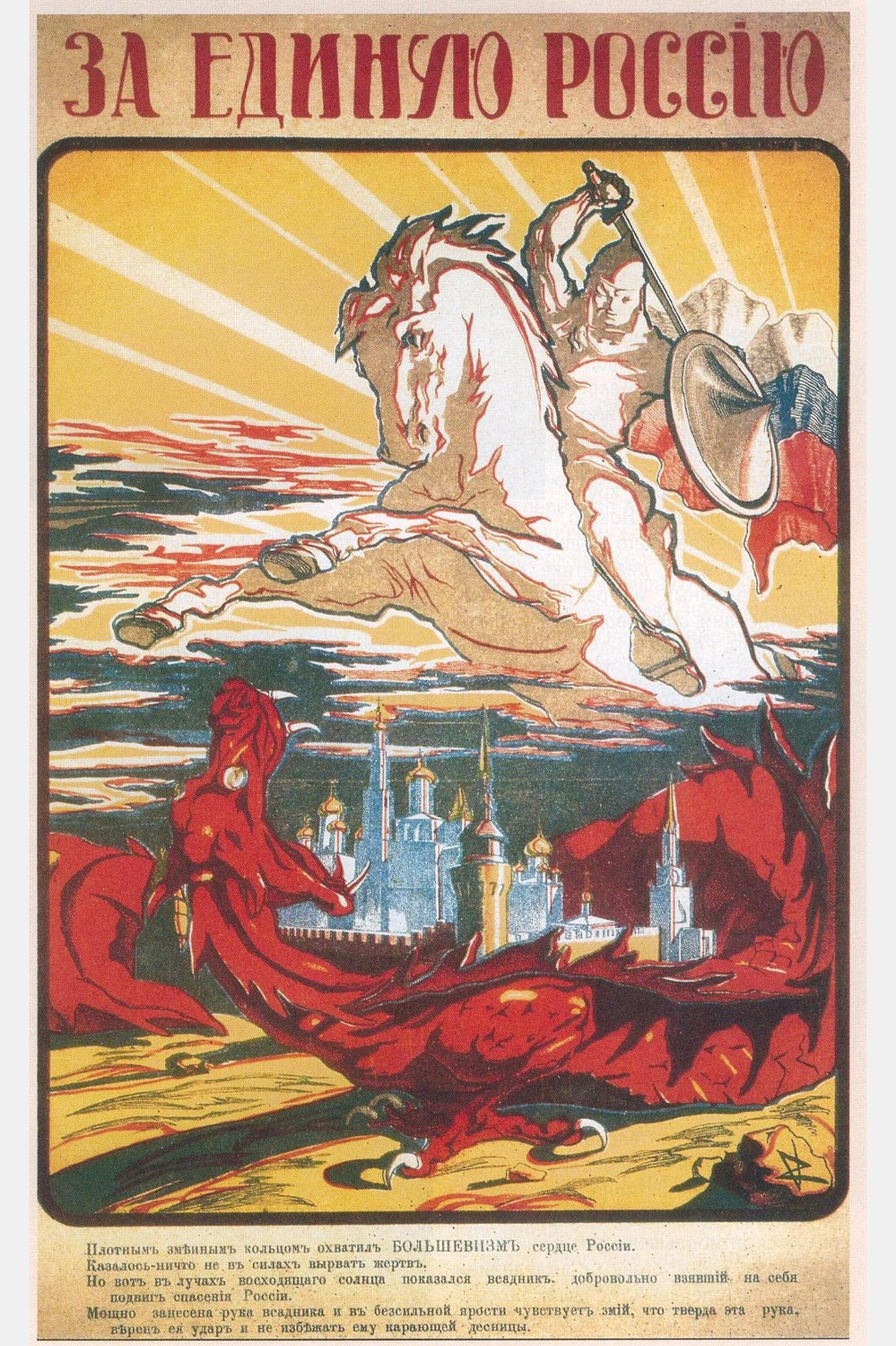
Propaganda poster of the White Army
In an effort to counter the Russian invasion, Ukraine turned to the West for help. Germany and Austro-Hungary were the first to recognise Ukrainian independence, and they provided the Ukrainian government with military assistance in the fight against the Bolsheviks. But the main word belonged to the Entente, the alliance of the victorious countries in the First World War, where France, the United Kingdom and the United States played a key role at the end of hostilities. The Russian Empire was a founding member of the Entente, and received considerable sympathy from the West, which largely perceived the Bolsheviks as Russia’s primary issue. The expansionist ambitions of the Bolsheviks did not find favour in Western eyes, leading to the imposition of economic sanctions and a diplomatic blockade against Bolshevik-controlled Russia. To militarily counter the Red Army, France deployed troops to Odesa in December 1918.
One would think that this was to help Ukraine in its struggle for independence. Well, it did not. Instead, support was given to the Russian imperialists, the White Army, consisting of former tsarist generals. These groups were intent on restoring the grandeur of pre-revolutionary Russia. This familiar imperial visage was what Russia’s Western allies, particularly France, were accustomed to and seemingly keen to reinstate.
The White Army
Representatives of the military-political movement in opposition to the Soviet power, active in 1917-1923. Names of their military corps: White Army, White Movement, White Guards, etc. (as well as the enemy side: Red Army, Red Army men, etc.) is related to the colour of the symbolism they used. However, the White Guards called themselves the Volunteer Army, and the commonly accepted name The White Guards started to be used only during Soviet times.To achieve their goals, as Russian propagandists convinced the West, it was essential to defeat not only the Bolsheviks, labelled as the “bad Russians,” but also all Russian “separatists” — a group in which they included Ukrainians, denying the existence of a distinct Ukrainian nation. Anton Denikin, the leader of the White Army, referred to Ukrainians as the “Small Russian branch of the Russian people.” He dismissed Ukraine as a “failed state”, alleging it to be a construct of the German General Staff.
Consequently, the White Guards, alongside the Bolsheviks and with backing from Western military forces, embarked on a mission to “liberate” Kyiv, which they called the “mother of Russian cities”.
“Kyiv is the mother of Russian cities”
This narrative is a misrepresentation of the phrase “Kyiv is the mother of Ruthenian cities,” said by Oleh, the Prince of Kyiv. It’s deeply rooted in imperialist and nationalist rhetoric of Russia, and is still widely used by the Russians.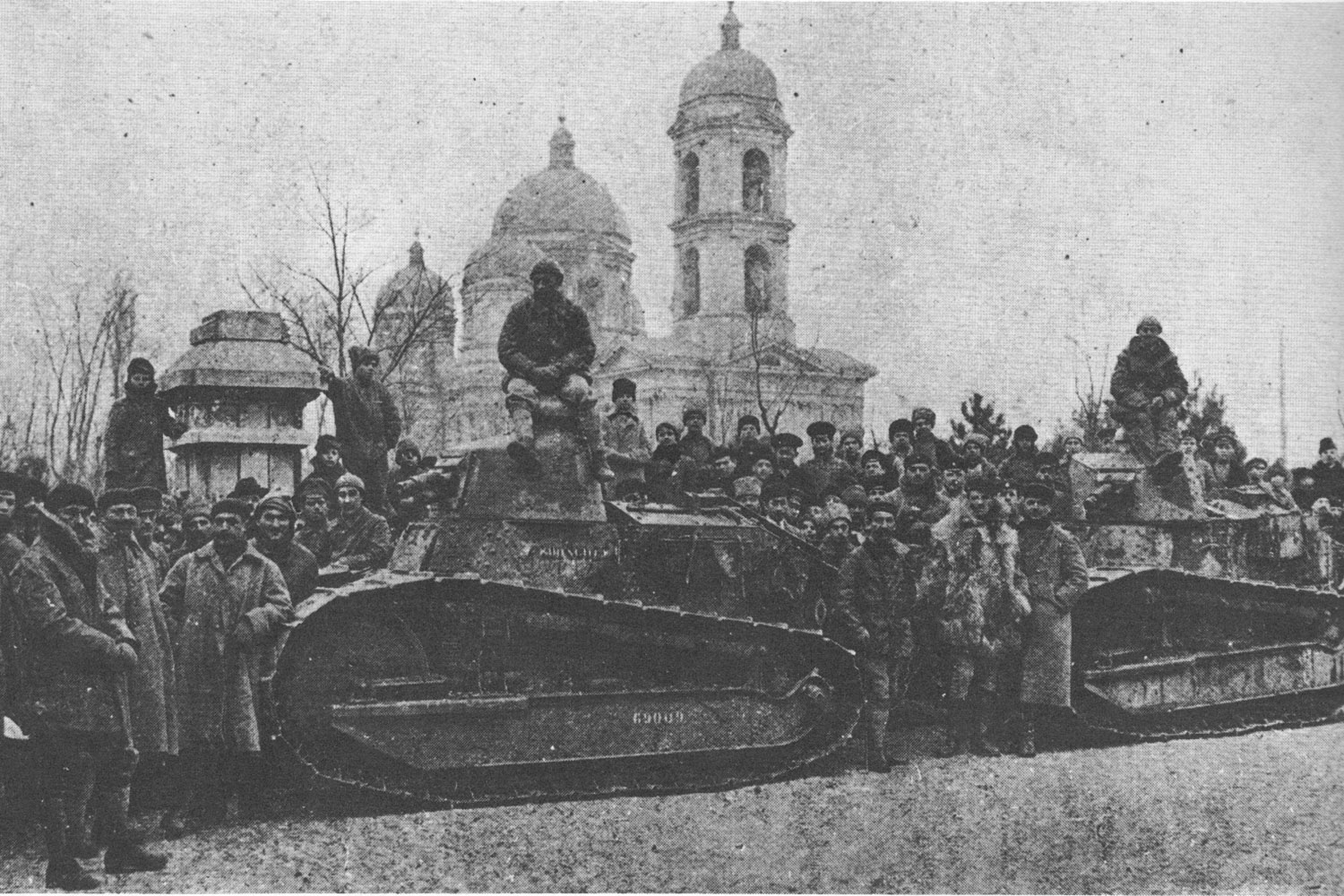
French soldiers with representatives of the White Guards on Renault tanks, Odesa, 1919
How can Ukrainians escape from this? How to convince the West that they are a separate nation from the Russians? This is where the song comes to the arena of Ukrainian diplomacy.
Ukraine’s cultural diplomacy after the World War I
Recognising the power of cultural diplomacy, Symon Petliura, the head of the Ukrainian state and commander-in-chief of the army of the Ukrainian People’s Republic (1879-1926), decided to showcase Ukraine to the world through its rich cultural heritage.
He dispatched a Ukrainian choir to the West in line with this strategy. This choir was not just a musical ensemble but a symbol of Ukrainian identity and a tool to gain international recognition and support during a tumultuous period in the nation’s history.
Symon Petliura understood that the traditional political rhetoric might not be sufficient to counter Russian propaganda, which had long influenced the West’s view of Ukraine. Instead, he believed in the power of music — a language that transcends cultural barriers — to alter Western leaders’ perceptions of Ukraine. This strategy aimed to convey the depth of the Ukrainian spirit and identity through song. Petliura’s deep involvement in culture significantly informed this approach. Having spent twenty years as an editor and journalist, he wasn’t just versed in politics; his expertise spanned theatre criticism, literature, and translation. He translated works from French to Ukrainian, delivered lectures on Ukrainian art history, and was personally acquainted with numerous Ukrainian cultural figures. His diverse cultural background equipped him to leverage the arts in diplomacy.
Symon Petliura’s fondness for concerts was pivotal in his cultural diplomacy. At one such event, he was deeply moved by Mykola Leontovych’s song “Legend”, performed by a choir under Oleksandr Koshyts’ direction on 1 January 1919. Struck by the song’s beauty, Petliura, as recalled by contemporaries, immediately instructed Koshyts to embark on a European tour with a particular emphasis on Paris.
This was a time-sensitive mission, as the Paris Peace Conference, Europe’s most significant diplomatic congress, was about to commence within a few weeks. World leaders from the victorious nations of World War I were set to gather there to shape the postwar world order.
At this conference, where the issue of Ukraine’s international recognition was anticipated to be addressed, the Ukrainian delegation hoped to leverage the principle of nations’ right to self-determination. This principle, recently advocated by US President Woodrow Wilson, held significant promise. Ukrainians were optimistic that the West would acknowledge their quest for independence in the same way as the rights of Poles, Finns, and Lithuanians.
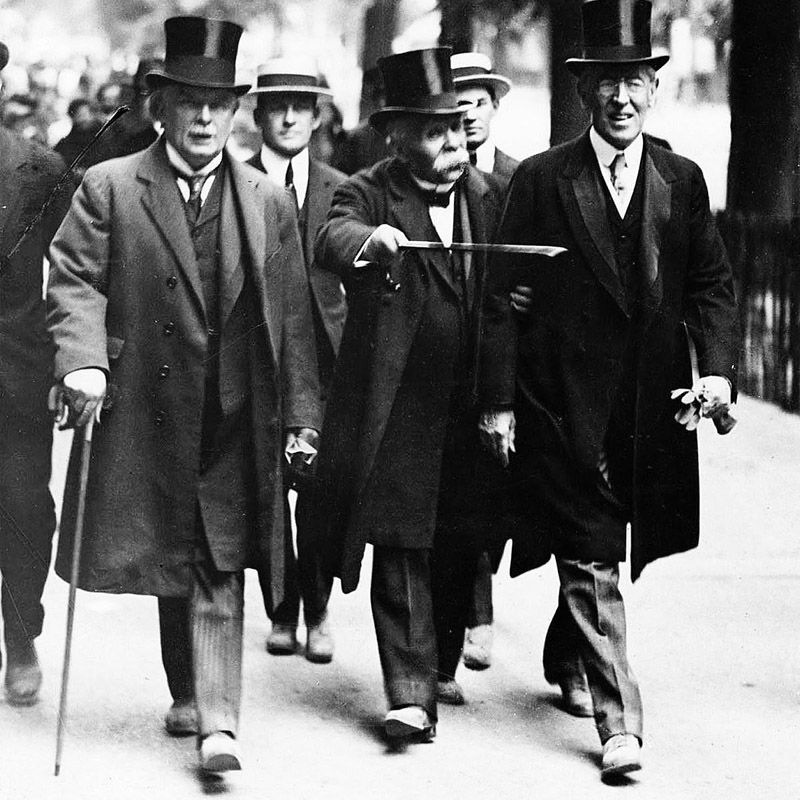
The leaders of the Entente in Paris, 1919 (left to right in the foreground): British Prime Minister David Lloyd George, French Republic Prime Minister Georges Clemenceau and the US President Woodrow Wilson
To demonstrate to the world the unique identity of the Ukrainian nation, the government initiated a talent competition. This competition sought the best singers from across Ukraine and involved renowned composers in a collaborative effort, with the government rapidly allocating budget funds for a European choir tour.
During this period, key figures directly approached Mykola Leontovych, requesting the inclusion of his songs in the tour. The composer, known for his modesty, declined, “My songs are so badly composed that they cannot be sung on a Prague or Paris stage.” However, with the Russian army’s advance towards the capital and no time left for persuasion, the choristers took Leontovych’s works without his permission. Tragically, the very next day, the Russian occupying forces entered Kyiv.
‘I sing, therefore I exist.’
The choir led by Oleksandr Koshyts made its premiere performance in Prague on 11 May 1919, three months after departing from Kyiv. The delay stemmed from the difficulties in crossing borders during a tumultuous time. Martial law reigned in Ukraine: railways lay in ruins, government ministries evacuated, and accessing promised government funds was challenging. With the Russian army advancing rapidly, the risk of capture or ending up in occupied territory was imminent. This dire situation forced the singers to walk nearly a thousand kilometres to the western border.
Despite their exhaustion, the Ukrainian singers delivered a successful premiere. That day marked the first international performance of “Shchedryk” by Mykola Leontovych, a significant milestone in Ukrainian musical history.
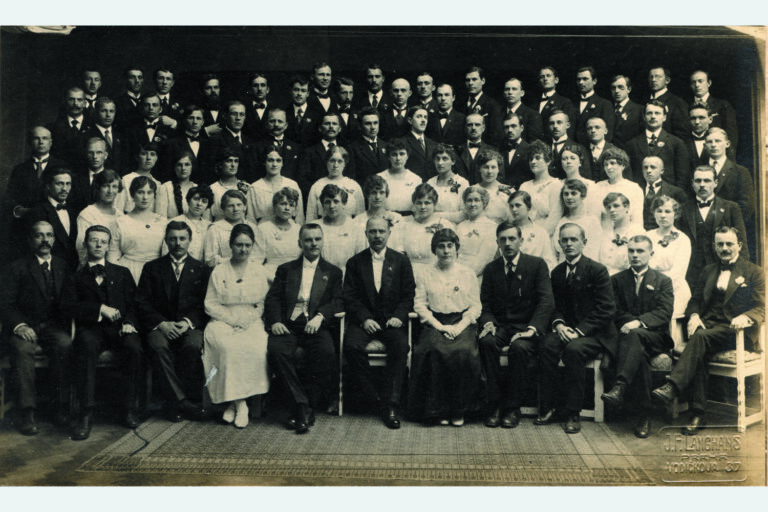
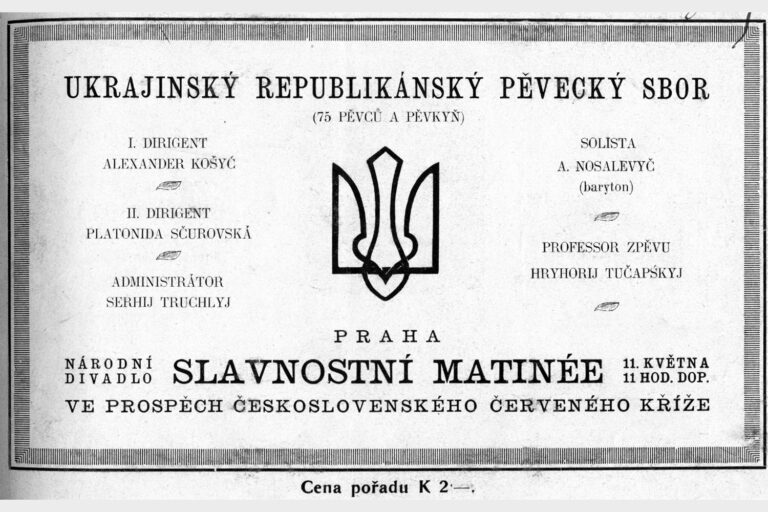
slideshow
Professor Zdeněk Nejedlý of Charles University enthusiastically admired Ukrainian music after the concert, “So, gentlemen modernists, who need 20 lines of music to express their worthless thoughts, try to do it in four lines, like Ukrainian composers!” The polyphony of Ukrainian songs and their simplicity and rhythmic sense instantly captivated Czech musicians. “Shchedryk” (Czech: štěbetavý Ščedryk) stood out for its resemblance to Czech Christmas carols, as noted by critics.
Symon Petliura’s hope that an appreciation for Ukrainian folklore would spark interest in Ukraine itself was realised. The renowned Czech conductor Jaroslav Kržička, who had previously been indifferent to Ukraine’s quest for independence, transformed after attending the choir’s concert in Prague. In his review for Hudebni Revue, he wrote, “It is difficult for my hand to write criticism when the heart sings praise. The Ukrainians came and won. I think we knew very little about them and deeply offended them by unknowingly and uninformed lumped them together against their will with the Russian people. Our desire for a ‘great and indivisible Russia’ is a weak argument against the distinct nature of the Ukrainian people, for whom independence is as vital as it once was for us.”
After their successful performances in Czechoslovakia, the choir moved on to tour Austria and Switzerland. They held concerts in Vienna, Baden, Lausanne, Zurich, Geneva, Basel, and Bern. The press overflowed with enthusiasm, with headlines and reviews proclaiming, “These songs are wonderful”, “We are witnessing a real phenomenon”, “Their voices echo the soul of an entire nation.” During this tour, Mykola Leontovych’s “Shchedryk” continued to gain widespread recognition, captivating audiences with its unique melody and embodying the rich cultural heritage of Ukraine.
“A work by the name ‘Shchedryk’, with its continuous repetition of four notes, with infinitely varied accompaniment and harmonisation, such worship songs are absolutely exquisite,” wrote a correspondent of the Geneva newspaper La Suisse.
The choir’s concerts continued to open Ukraine to Western audiences. More than a hundred reviews had been published, with many critics increasingly and actively supporting Ukrainians in their struggle for independence.
“The Ukrainian Republic is striving to restore its independence,” wrote a correspondent for the Swiss newspaper La Patrie Suisse, “and decided to demonstrate that it really exists. ‘I sing, therefore I exist,’ it says. And it sings amazingly.”
“Ukraine’s cultural maturity should legitimise its political independence in the world,” the Viennese press summed up.
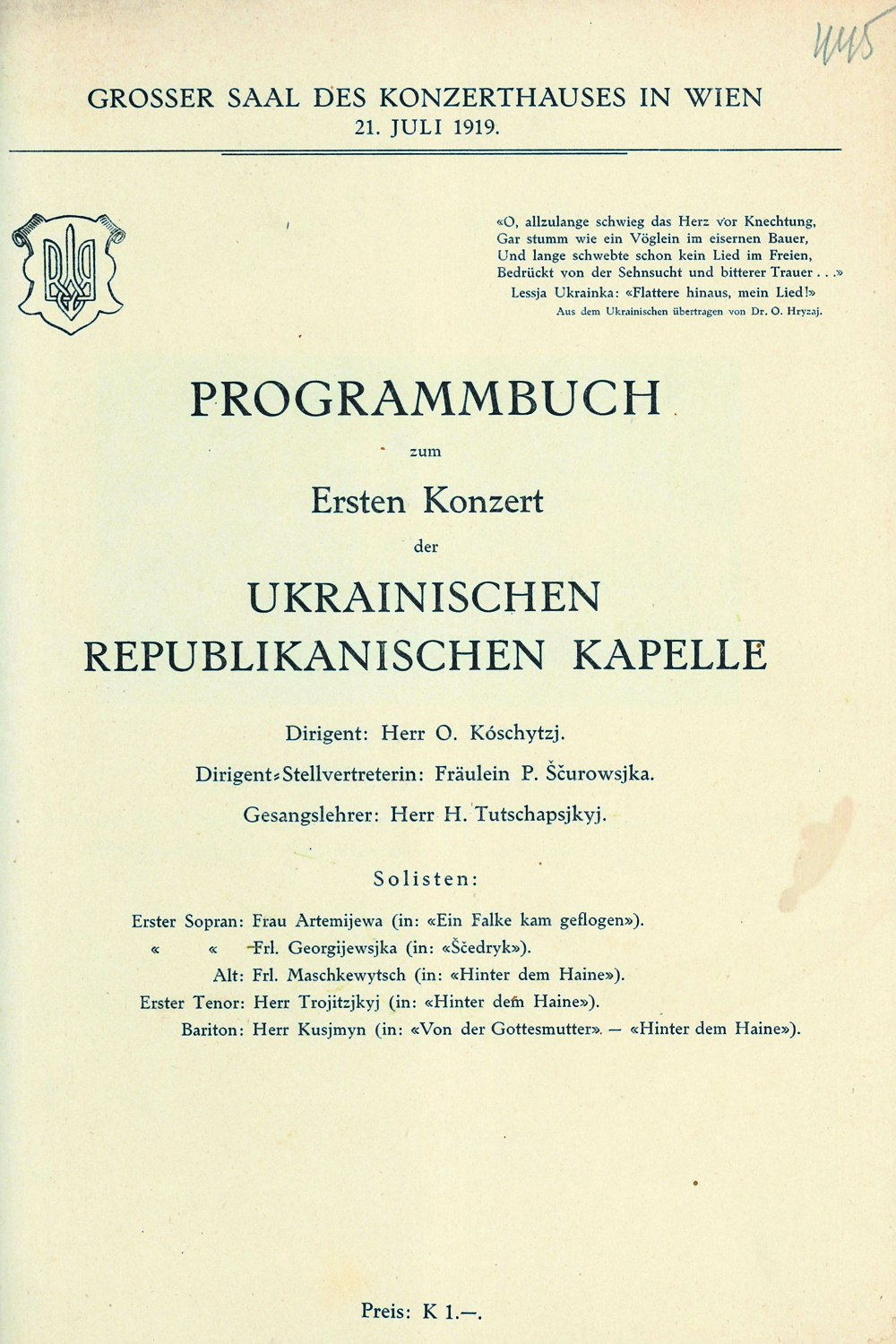
Booklet of the Ukrainian premiere in Vienna. Source: Central State Archives of Supreme Bodies of Power and Government of Ukraine
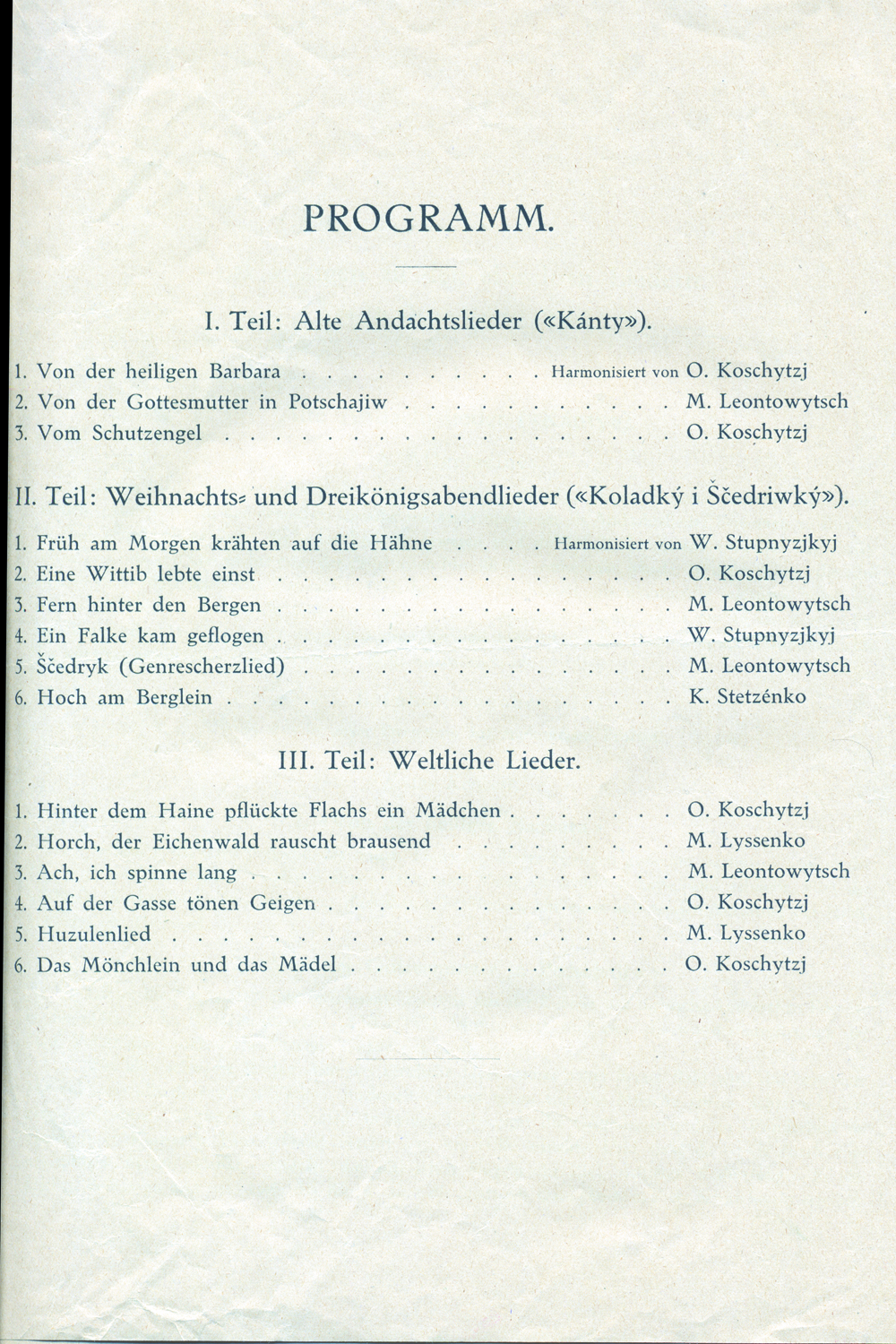
“Shchedryk” by Mykola Leontovych in the repertoire. Source: Central State Archives of Supreme Bodies of Power and Government of Ukraine
If only the Parisian press had echoed the same sentiments! However, as representatives of an unrecognised state, Ukrainians faced significant barriers in France. Even the official diplomatic mission of the Ukrainian People’s Republic (UPR) was not permitted to participate in the Paris Peace Conference meetings. Western leaders, it seemed, preferred to discuss Ukraine in the absence of its representatives.
Yet, a significant breakthrough occurred when the French ambassador attended a Ukrainian concert in Bern. Captivated by the Ukrainian choir’s performance, he was moved to write a letter of recommendation to the French Minister of Foreign Affairs, and in October 1919 he gave the choir permission to go on tour.
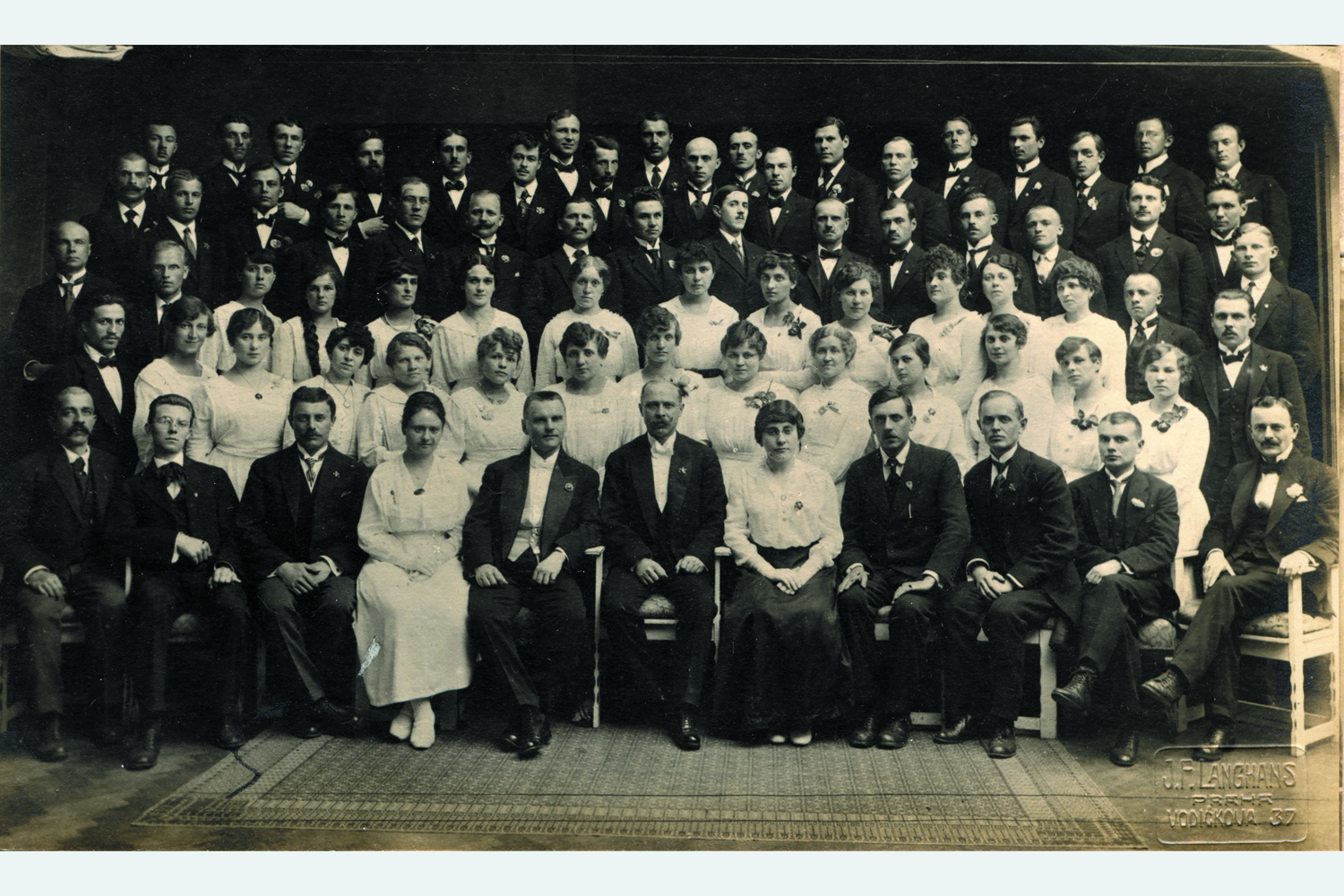
Ukrainian choir together with the head of the diplomatic mission of the UPR Mykola Vasylko in Bern, Switzerland, 1919. Source: Central State Archives of Supreme Bodies of Power and Government of Ukraine
‘We who are about to die, salute you!’
Nine months after they departed from Kyiv, on 3 November 1919, the Ukrainian singers finally arrived in Paris. By that time, the fate of Ukraine had largely been decided by the leaders of the Entente. In a series of agreements, Ukrainian territories were partitioned among neighbouring states: central Ukraine was ceded to Russia (under the control of the White Army), Halychyna (Galicia) to Poland, Bukovyna to Romania, and Zakarpattia (Transcarpathia) to Czechoslovakia. Tragically, Ukraine’s plea for independence went unrecognised by the Western world. The right to self-determination for the forty-million-strong Ukrainian nation was, regrettably, overlooked.
The division of Ukraine
On 26 May 1919, the Supreme Council of the Paris Peace Conference recognised Admiral A. Kolchak, a leader of the White Army, as the supreme ruler over all territories of the former Russian Empire, including part of Ukraine. Halychyna was ceded to Poland on 25 June 1919, stipulating that the region would receive autonomy and the Ukrainians would be granted political, religious, and personal freedoms. However, these conditions were not fulfilled by the Polish government. Zakarpattia (Transcarpathia) was ceded to Czechoslovakia in a separate development, as outlined in the Treaty of Saint-Germain (10 September 1919). Bukovyna was allocated to Romania under the terms of the Treaty of Trianon (4 June 1920).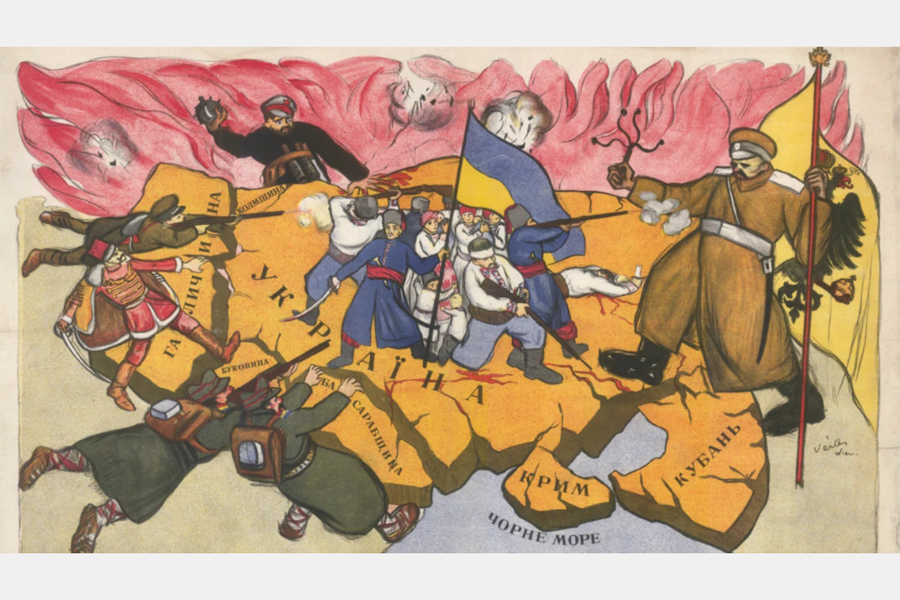
Poster “World peace in Ukraine!”, by Georg de Gasenko and Verté, 1919
Even then, Symon Petliura had not given up hope of international support. In the autumn of 1919, when the Ukrainian army was surrounded by enemies, he asked the leaders of the Entente to give Ukraine if not weapons, then at least medicines, and to send representatives of the Red Cross to the wounded Ukrainian soldiers.
“Three-quarters of our Kozaks are without boots and clothes; however, their spirit is not extinguished!” wrote Symon Petliura to the head of the Bureau of Nationalities of the French Parliament, Jean Pelissier. “We have no medicine; typhus is decimating the ranks of our army, many wounded are dying because we don’t have medicines and blankets. And the Entente Powers, proclaiming high principles, forbid the Red Cross to come to us! We are dying, and the Entente, like Pilate, is washing its hands, and we have nothing left to do but to shout to them: ‘Morituri te salutant!’”
“Morituri te salutant!”
The traditional greeting of gladiators to Caesar before their entrance into the arena (“We who are about to die, salute you” — ed.)The choir’s concerts in Paris were both a sad and a grandiose spectacle. On 6 November 1919, Ukrainian singers took the stage of the Gaveau theatre in Paris, with the words “We who are about to die, salute you” in the air. Even so, Russian emigrants tried to disrupt the premiere: they wanted to boo the Ukrainian anthem and declare the choir members enemies of France. But they failed to do so.
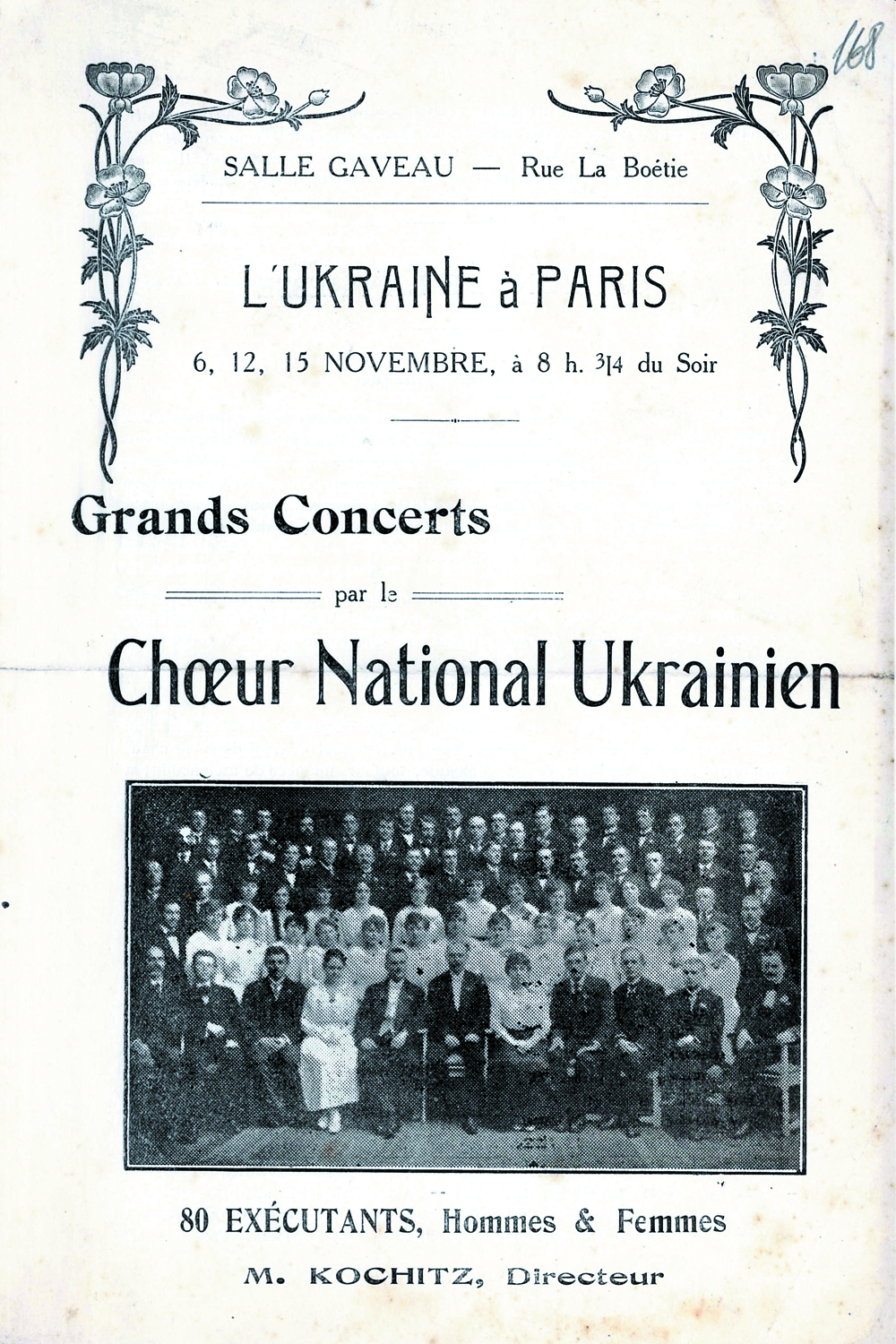
Posters of the Ukrainian premiere concerts in the Gaveau Hall in Paris, November 1919. Source: Central State Archives of Supreme Bodies of Power and Government of Ukraine
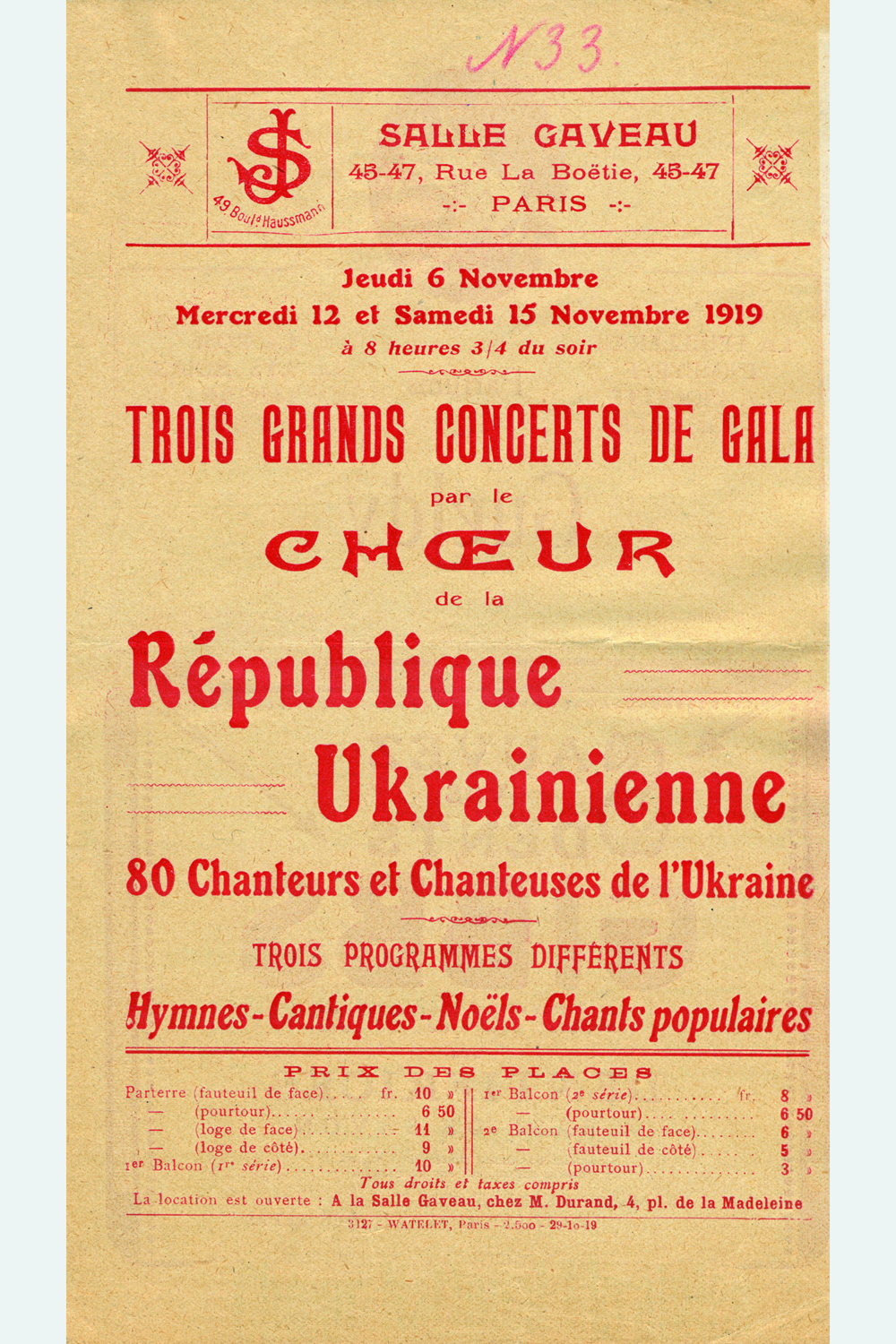
Posters of the Ukrainian premiere concerts in the Gaveau Hall in Paris, November 1919. Source: Central State Archives of Supreme Bodies of Power and Government of Ukraine
“No choir, French or foreign, has ever presented anything like it,” wrote a critic of the Le Nouvelliste. “This choir has been a revelation to us, it is of the highest calibre,” commented journalists from the Le Figaro newspaper.
The song by Mykola Leontovych also gained special affection from the public. A correspondent of The New York Herald in Paris noted, “In the repertoire of Ukrainians, we liked the gradation of motifs, their characteristic orientalism, as well as explosions of sincere cheerfulness, especially in ‘Shchedryk’, songs that begin with a sudden attack, and in which the effects of really great humour are being formed by the simple gradation of voices.”
Orientalism
19th century art movement that had an extensive use of Eastern motifs, plots, and styles. In a broader sense, it is the idea of the East (oriens in Latin means East, orientalis – Eastern — ed.), apprehension of the East, which is traditionally contrasted with the idea of the West.In addition to “Shchedryk”, the Parisian public admired other songs of the composer: “I am spinning, spinning ”, “Oh there, beyond the mountain”, and especially chant (church song for choir) “To the Pochayiv Mother of God”. The Parisians translated it in their own way — “Notre Dame de Potchaïv”. This ancient work was written by Mykola Leontovych as a student from the mouth of a lark in one of the Ukrainian villages in Podillia.
Other Ukrainian songs played at concerts were arranged by well-known composers. Among the most popular were: “On the Hill” by Kyrylo Stetsenko, “A violin is playing in the street” by Oleksandr Koshyts, “She went for honey mushrooms” by Mykola Lysenko, as well as the anthems of Ukraine and France.
“Your choir singers have exceeded all my expectations,” wrote professor Charles Seignobos of the Sorbonne in a letter to Oleksandr Koshyts. “I felt something similar a long time ago when I listened to Wagner’s works in Munich. No propaganda could be more effective for the recognition of the Ukrainian nation.”
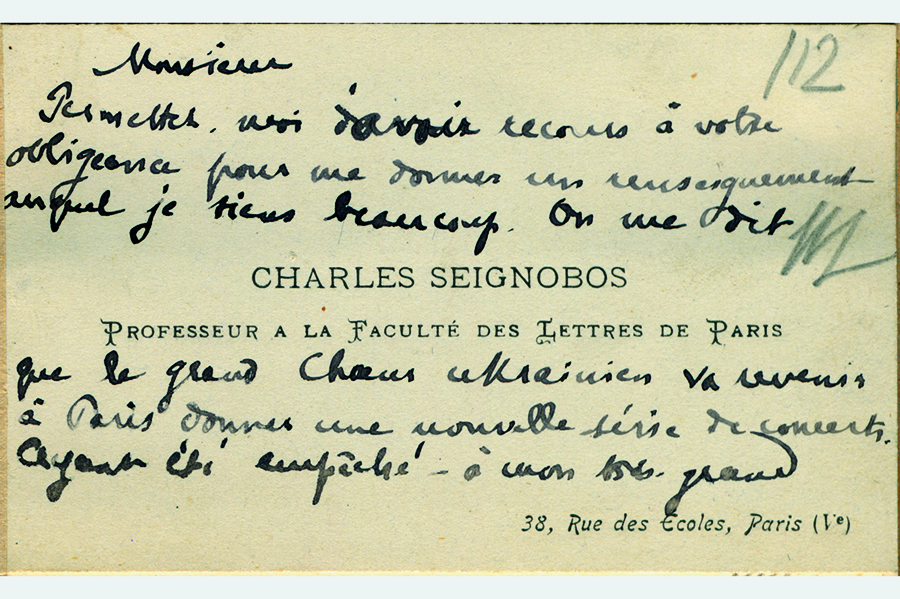
Сalling card of Charles Seignobos. Source: Central State Archives of Supreme Bodies of Power and Government of Ukraine
However, “the propaganda” turned out to be too late, the French government delayed visas for singers for too long. Now, Ukraine had been already occupied, so they had no choice but to continue to bring Ukrainian art to the world. Moreover, the demand for it had increased in direct proportion to the loss of hopes for international support for Ukraine.
‘Why hasn’t this school of music been known to us before?’
In November and December 1919, the choir of Oleksandr Koshyts performed in Bordeaux, Toulouse, Lyon, Marseille and Nice. Everywhere, as Symon Petliura had hoped, the French public reached political conclusions. A professor of the Toulouse Conservatory, Georges Guiraud, wrote after the premiere in Toulouse, “They said that Ukraine is a part of Russia, why did the Russian government hide Ukrainian music from Europeans?”
“We know the names of famous Russian composers: Borodin, Rimsky-Korsakov, Mussorgsky,” he noted in his article in the newspaper L’express du Midi, “but there was never any mention of Ukrainian composers. Why has this school of music not been known to us until now? Was it destroyed by the weight of the glory of the great Russian colleagues?”
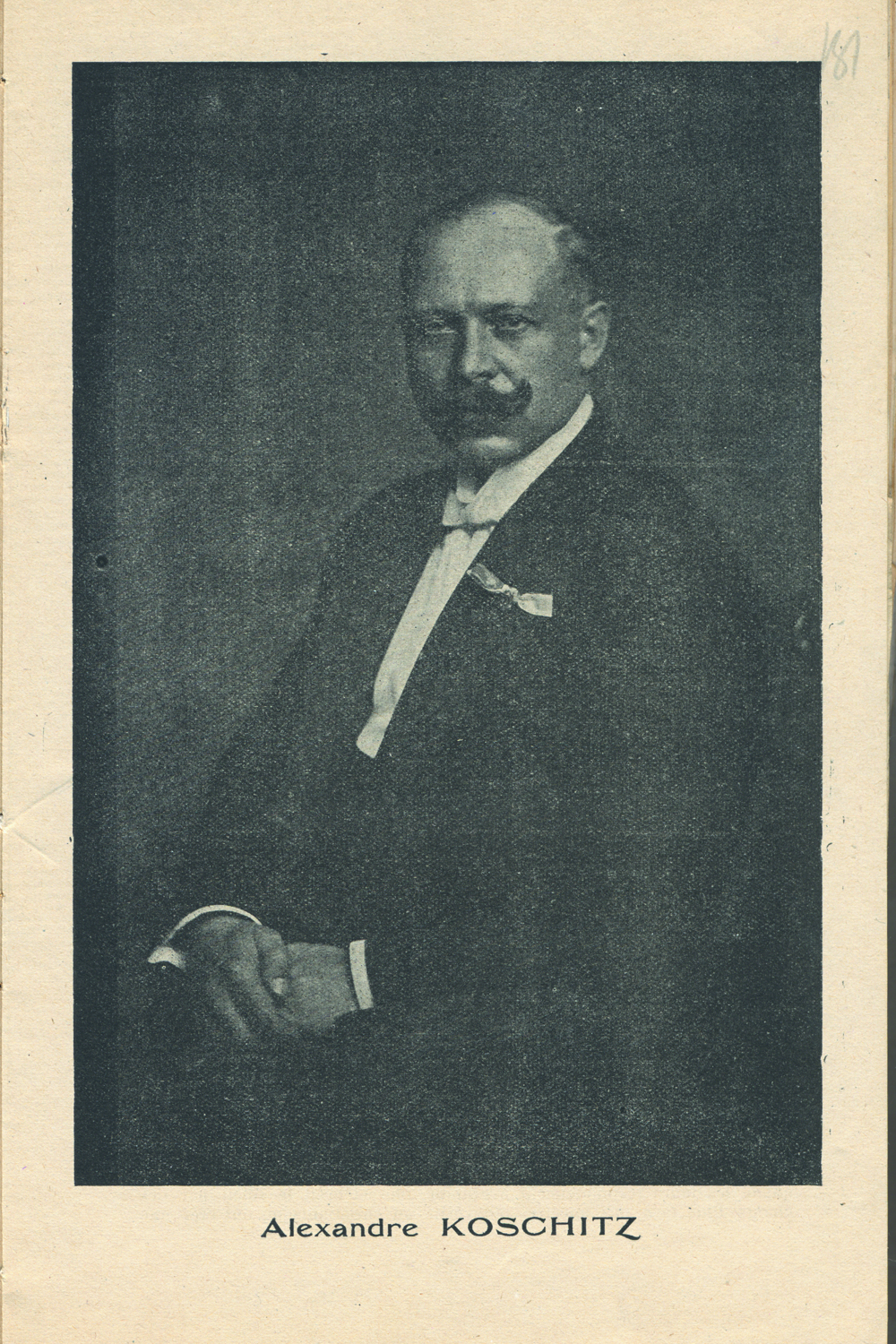
Portrait of the composer Oleksandr Koshyts from the booklets of Ukrainian concerts in France, 1919. Source: Central State Archives of Supreme Bodies of Power and Government of Ukraine
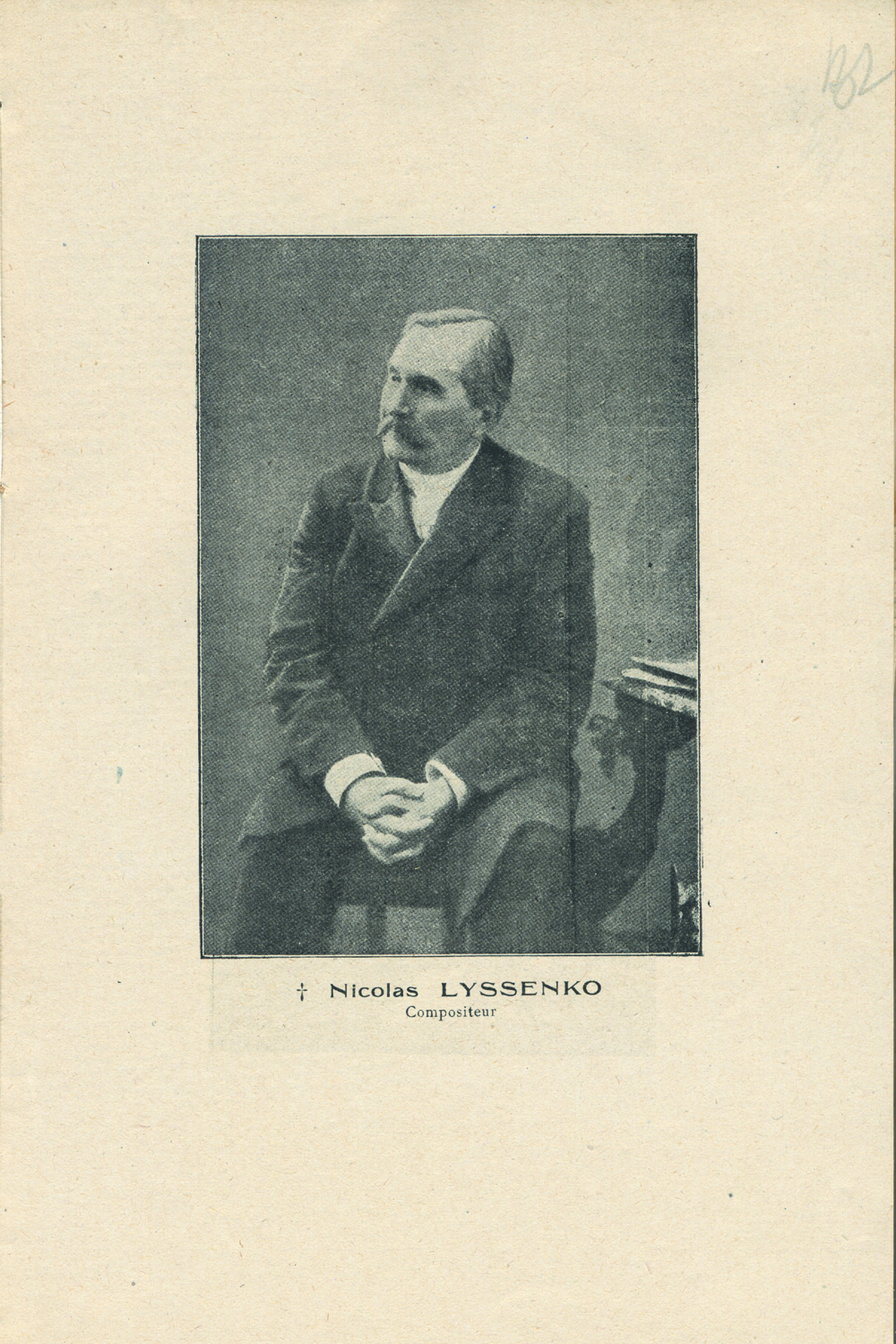
Portrait of the composer Mykola Lysenko from the booklets of Ukrainian concerts in France, 1919. Source: Central State Archives of Supreme Bodies of Power and Government of Ukraine
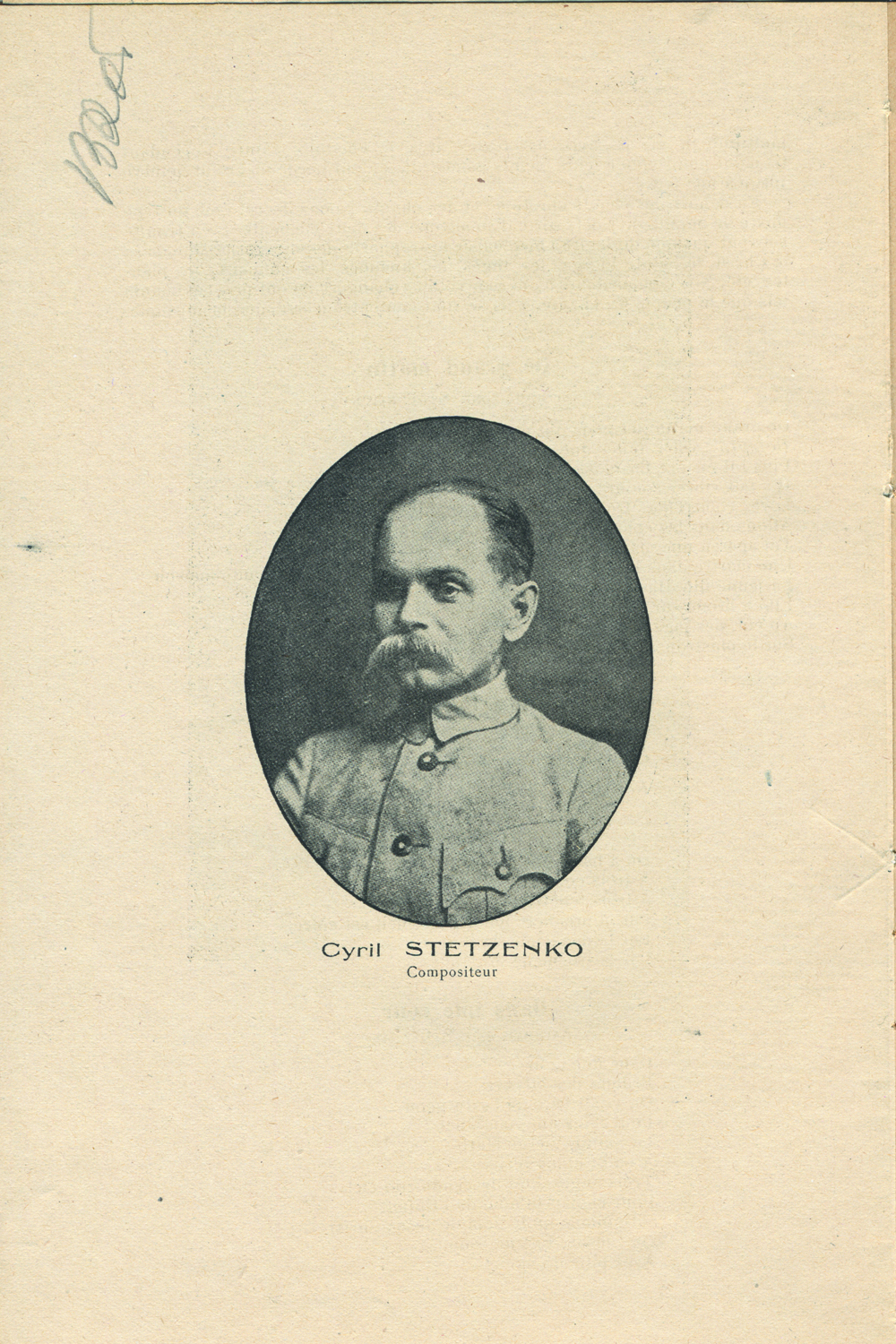
Portrait of the composer Kyrylo Stetsenko from the booklets of Ukrainian concerts in France, 1919. Source: Central State Archives of Supreme Bodies of Power and Government of Ukraine
For a long time, the Russian government not only hid Ukrainian music from the world, but also forbade Ukrainians to perform it. Long time before in 1863, the Minister of Internal Affairs of Russia Pyotr Valuyev issued a circular (Valuyev Circular) forbidding Ukrainians to print not only Ukrainian-language books, but also the texts of Ukrainian folk songs. Another such document, known as the Ems Decree, was issued in 1876 by Tsar Alexander II. Even Ukrainian-language performances and concerts with Ukrainian musical repertoire were banned. The founder of the Ukrainian music school, Mykola Lysenko (1842-1912), the teacher of Mykola Leontovych, was called a “separatist composer” by the Tsarist Russian officials, and his works were censored. Even Symon Petliura was expelled from the last year of the seminary in 1901 because a student choir under his direction had performed an unauthorised cantata by Mykola Lysenko, “Rapids rage”, which was banned by the authorities.
So only with an independent Ukraine, the Ukrainian choir eloquently hinted to the French that Ukrainian culture could be present in the world and exist at all.
At one point, the Ukrainians almost succeeded in conveying this to the political leadership of France: the choir’s concerts caught the eye of Thérèse Clémenceau, the daughter of French Prime Minister George Clemenceau, who presided over the Paris Peace Conference. She promised Oleksandr Koshyts to organise choral performances at the Paris National Opera and to bring his father, a supporter of a “united and indivisible Russia”, there.
However, the Ukrainians were once again rejected. It was said that the performance of the choir in the state theatre of Paris would be equated to the political recognition of Ukraine’s independence by France. “I asked about the opera house,” Clemenceau wrote to the choristers. “Indeed, we cannot provide you with a stage for performances in the theatres we support”.
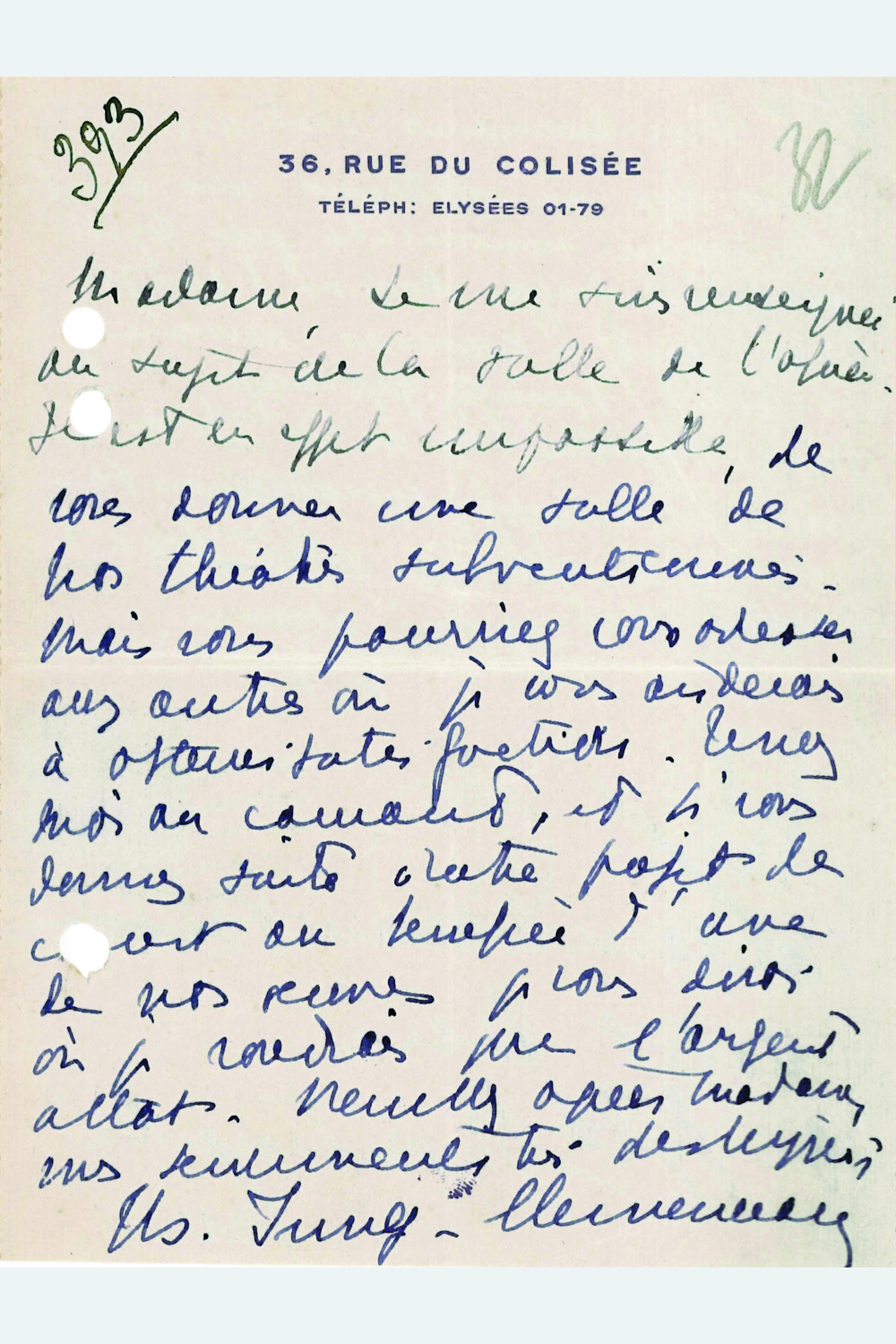
A letter from Thérèse Clémenceau to the choir, December 1919 Source: Central State Archives of Supreme Bodies of Power and Government of Ukraine
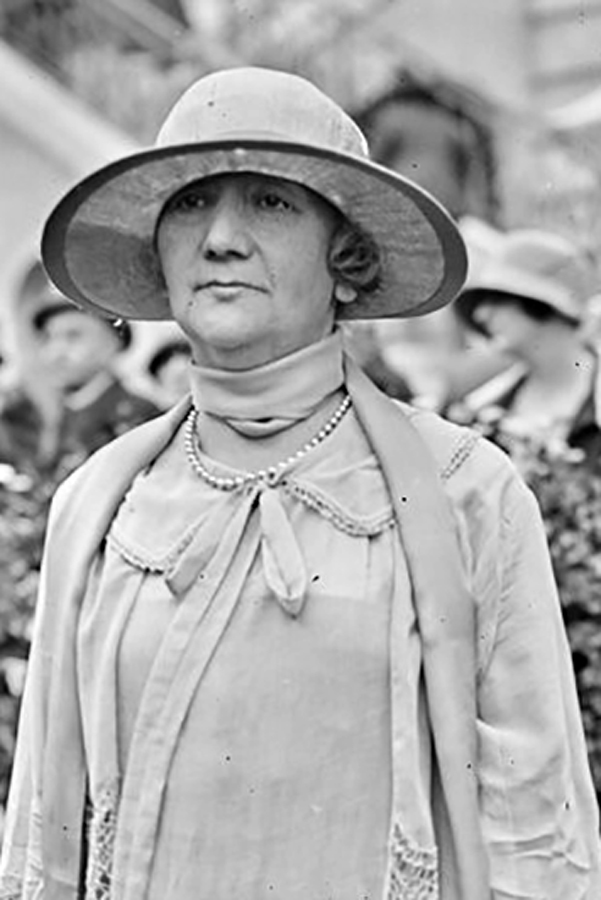
Thérèse Clémenceau
Ukrainian Carol singers were left with nothing. So was the Ukrainian state. As was composer Mykola Leontovych, who at this time was forced to hide from the terror of the Russians in occupied Kyiv.
Russian persecution of Mykola Leontovych, creator of ‘Carol of the Bells’
Mykola Leontovych indeed had to hide. After the capture of the Ukrainian capital in February 1919, the Russian Bolshevik army committed a terror attack there. Ukrainians were shot and buried in mass graves.
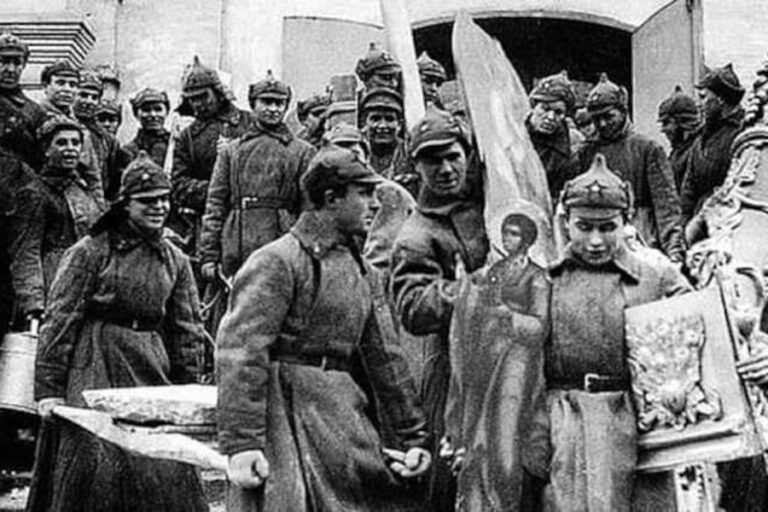
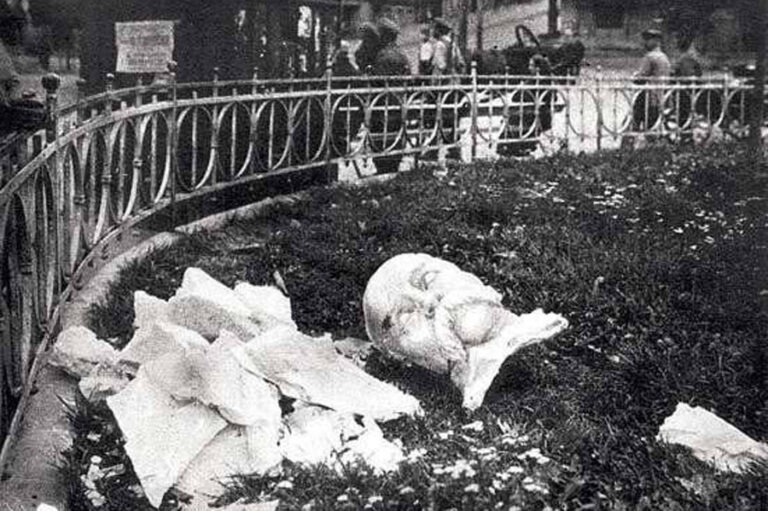
slideshow
Red terror changed to white when Kyiv was “liberated” by the Western-backed Russian White Guard in August 1919. They prohibited Ukrainians from using the word “Ukraine”, destroyed the portraits of the national poet Taras Shevchenko and began the persecution of Ukrainian activists. In November 1919, they shot Ukrainian writers Hnat Mykhailychenko and Vasyl Chumak, employees of the magazine Mystetstvo (Art — ed.).
It was then when Mykola Leontovych decided to flee the capital. “The Black Hundreds were looking for me, so I had to leave Kyiv,” he told his friend Yakym Grekh.
The Black Hundreds
The name given to Russian monarchists and ultra-nationalists who advocated Russian autocracy and the indivisibility of the Russian Empire, committed Jewish pogroms, and did not recognise Ukrainians and Belarusians as separate peoples. They formed the backbone of the White Russian Army.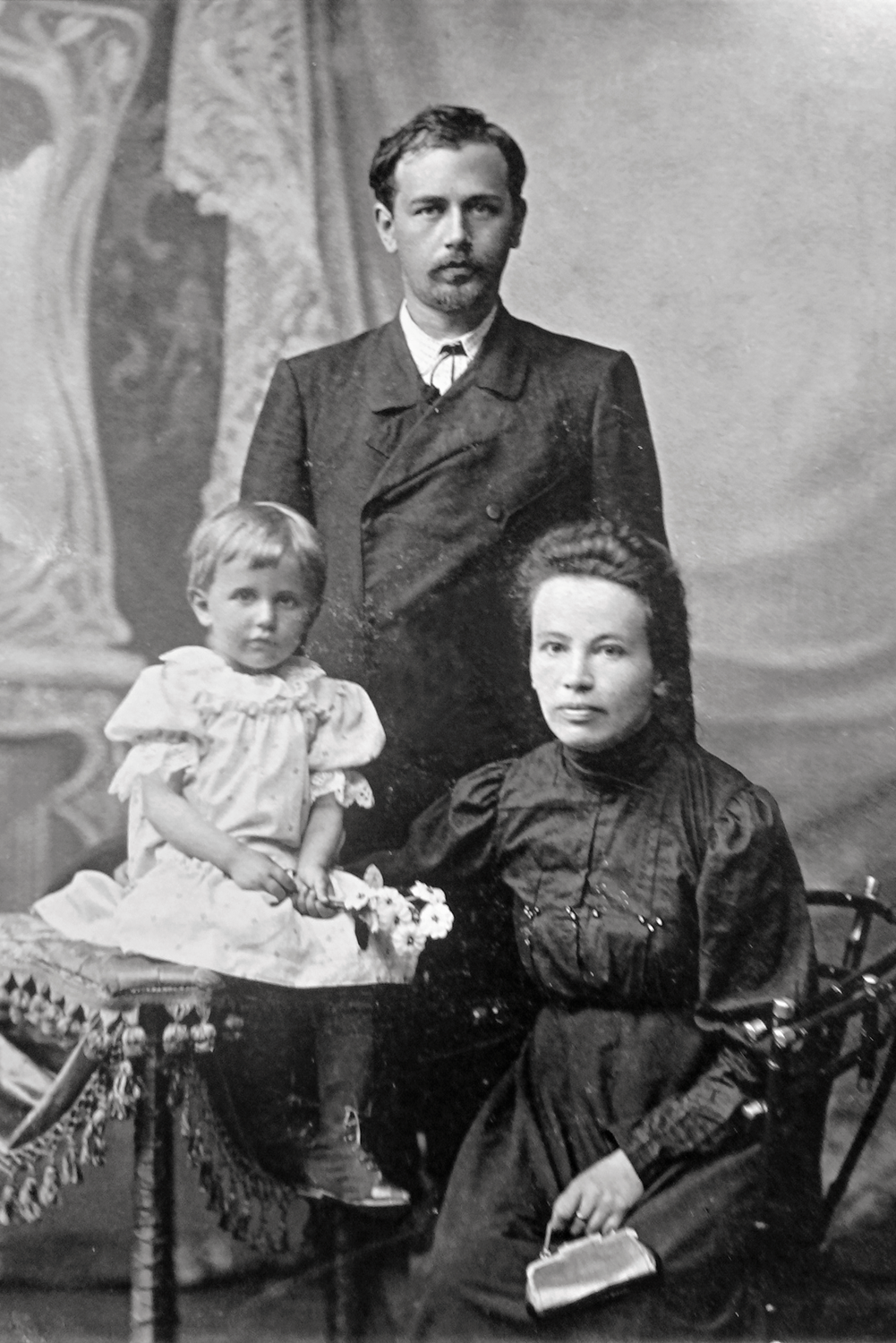
Mykola Leontovych with his wife and daughter, 1903
In November 1919, when his “Shchedryk” was receiving ovations from the French public, the composer left Kyiv. “In a light summer coat on his shoulders and a pale hat, terribly sick,” contemporaries mentioned. By foot, he reached the town of Tulchyn in Podillia. The road was more than 300 km long.
The next two years were the most miserable period of Mykola Leontovych’s life. He, his wife and their two daughters lacked the basics of food and clothing. “My parents often sent me to visit my grandfather in Markivka for various religious holidays,” recalled the composer’s daughter, “they hoped that I would bring some food when I returned.”
Even in such conditions, Mykola Leontovych continued to create. Immediately after escaping from Kyiv, he took up writing his first opera. Working in poverty, the composer had no idea of the scale of his international fame. And it was magnificent.
‘Shchedryk’ for the encore!
“Shchedryk” in the arrangement of Leontovych, is a masterpiece of folk art,” wrote a correspondent of the Brussels newspaper Le XX Siècle on 10 January 1920.
“Many songs were sung after encores. Among the most original and beautiful ones were “Shchedryk” and “Oh there, beyond the mountain”, both created by Leontovych.” This was a review of the 4 February 1920 edition of The Daily News and Leader in London. “The public noted that they liked Leontovych’s arrangements, which were called for encores the most”, as was written in the Barcelona magazine Das Noticias in February 1921.
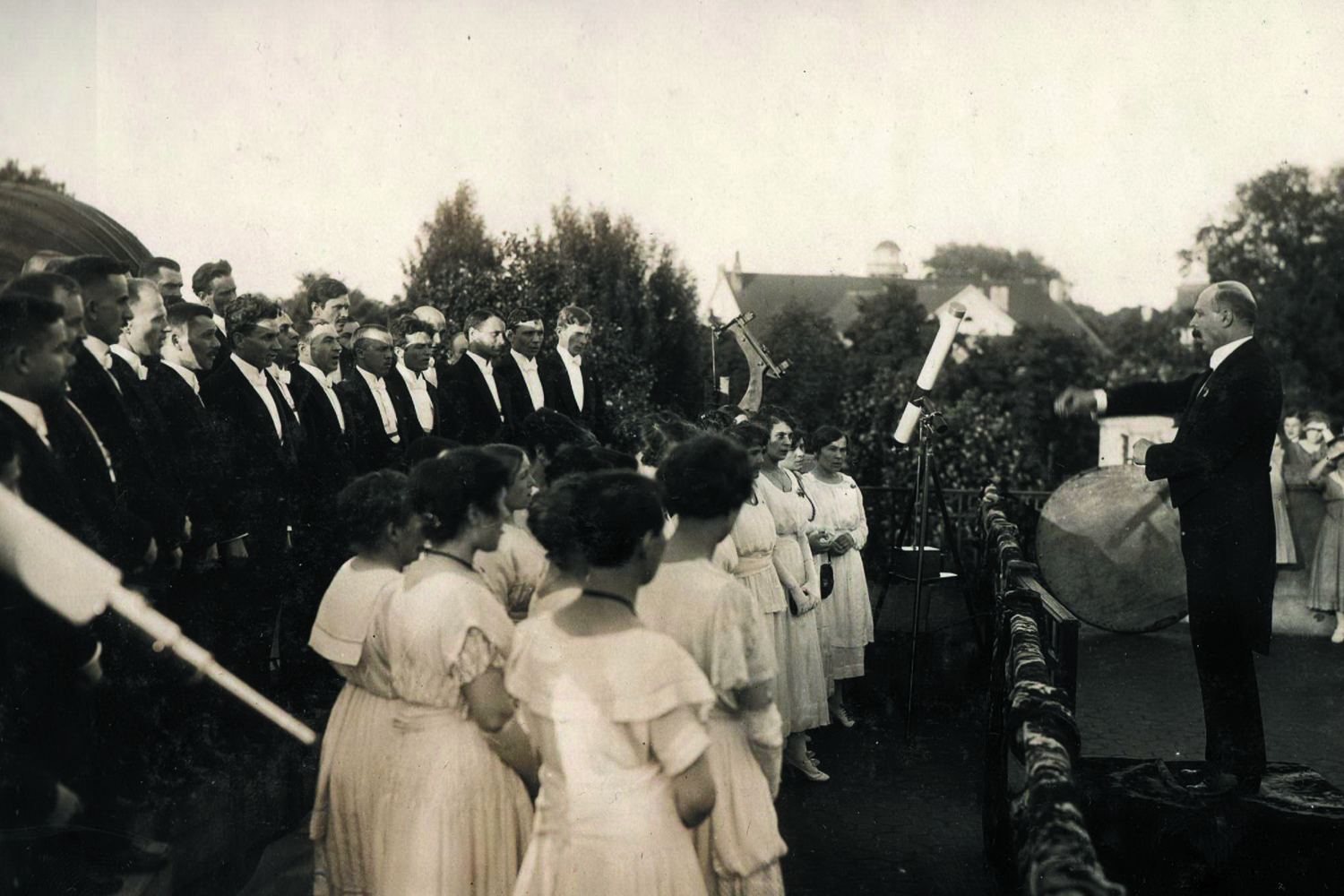
The Ukrainian Choir in Berlin, 1920 Source: Ukrainian History and Education Center, Somerset, U.S.A. The article was originally published by the Watchtower Society of New York, Inc.
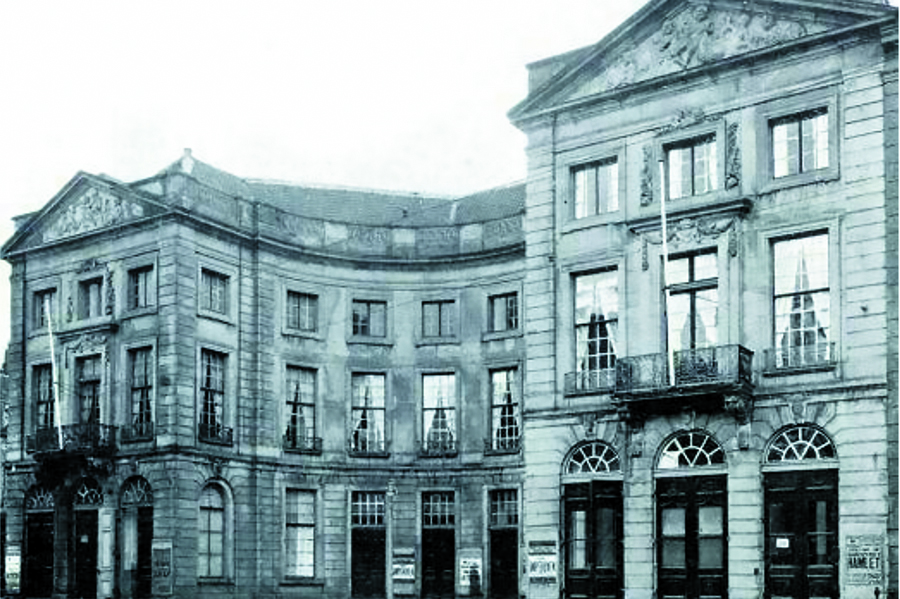
The Royal Opera Theatre in Hague, where Ukrainians performed in January 1920
After completing a tour in France, the choir performed with great success in Belgium, the Netherlands, Great Britain, Germany, Poland, and Spain. Some of the singers even went to Africa (Algeria, Tunisia). At all concerts, compositions by Mykola Leontovych, especially his “Shchedryk”, were a hit of the tours and a musical calling card of Ukraine.
“The audience welcomed us warmly; we sang ‘Shchedryk’ for the encore,” wrote the choir singer Sofia Kolodiivna in her travel diary about the premiere in Rotterdam. “The concert was attended by reviewers from all Amsterdam magazines. For the encore, we sang ‘Shchedryk’,” she wrote about the performance in Amsterdam. “We sing well, with a good mood. For the encore, we sing ‘Shchedryk’ by Leontovych,” she noted about the premiere in The Hague.
It was in the Netherlands that the song of Mykola Leontovych gained the greatest popularity. In the kingdom’s capital, The Hague, it was sung simply in the streets. Chorister Pavel Korsunovsky recalled how the morning after the concert at the Royal Opera, they were awakened by the cries of journalists.
“But we realised it wasn’t the names of the newspapers they were calling,” he wrote in his memoirs.”’It was the singing, ‘Shchedryk, shchedryk’. And they sang it nonstop. Sleep was impossible. My friend and I got dressed and went to the hotel dining room for breakfast. At the general table, we heard again, “Shchedryk, shchedryk”. Somewhere on the street, an older lady unexpectedly ran up to us and also said, ‘Shchedryk, shchedryk…’.”

